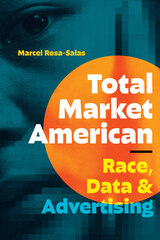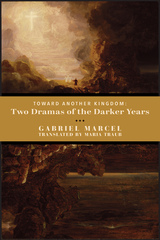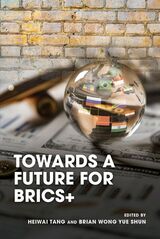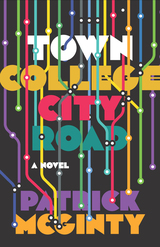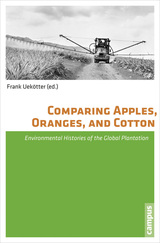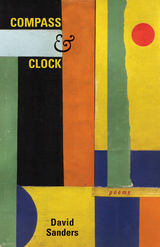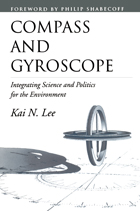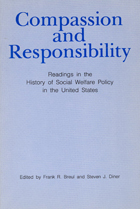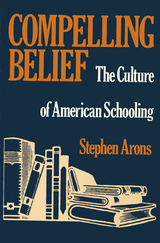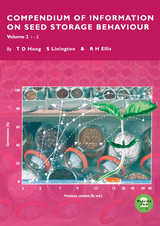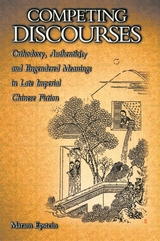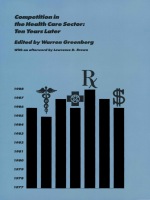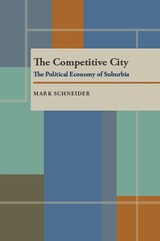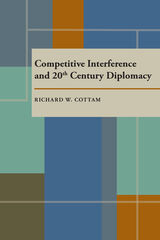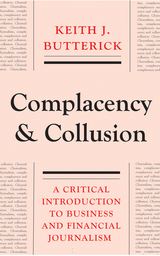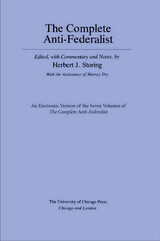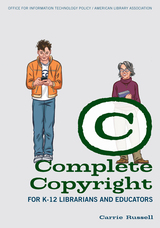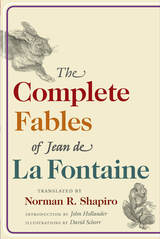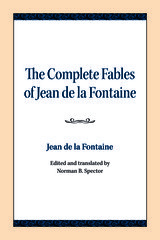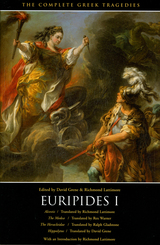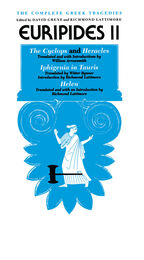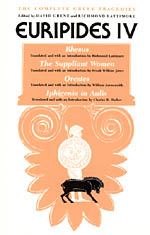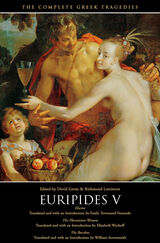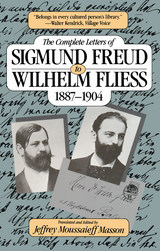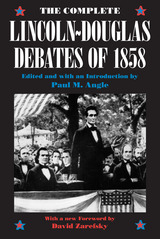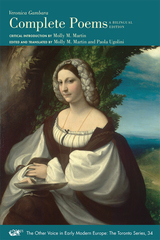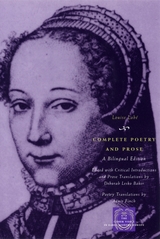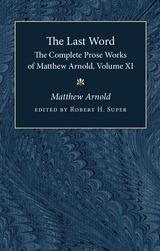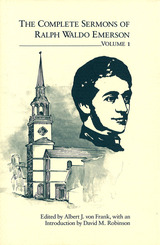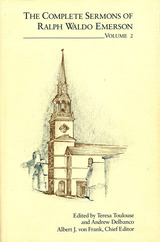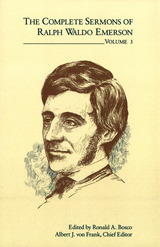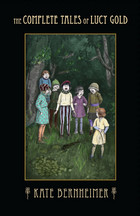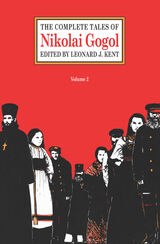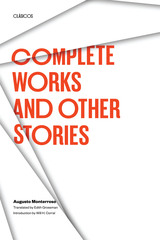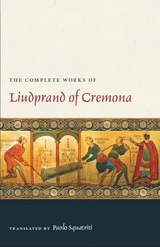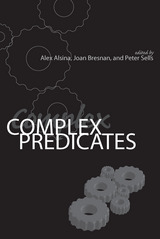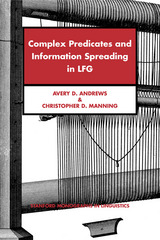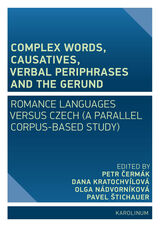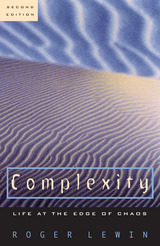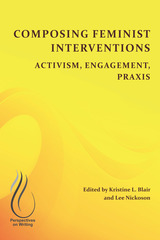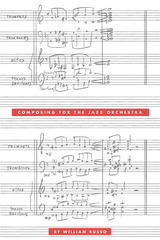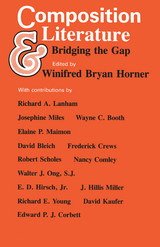Comparative Studies in Greek and Indic Meter
Gregory Nagy
Harvard University Press, 1974 Reversing the generally accepted notions about formula and meter in epic poetry, Gregory Nagy seeks to show that meter is an outgrowth of formula. To make his point he links the Parry-Lord techniques of formulaic analysis with the researches of Meillet, Jakobson, and Watkins on Indo-European metrics. In the process he evolves a new theory about the origins of the Homeric hexameter and offers controversial fresh material for pursuing the problem of creativity versus tradition in the Greek lyric.
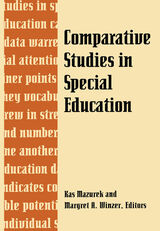 Comparative Studies in Special Education
Kaz Mazurek
Gallaudet University Press, 1994 This unequaled collection of international programs will enable educators worldwide to investigate special education practice within its social context to enhance their own initiatives with new ideas.
Comparative Studies divides into five sections, each with an introduction to the chapters within. This thorough text begins with limited special education in such venues as South Africa and Senegal. Section Two addresses emerging special education in Nigeria, Brazil, and several other locales. Segregated special education in Japan, Russia, and other countries makes up Section Three, and Section Four explores countries that are approaching integration, such as Poland and Australia. Integrated special education is described in Scandinavia, New Zealand and other nations in the final section.
More than 50 noted scholars have contributed to this important work, offering an indispensable, detailed frame of reference for assessing education programs worldwide for all special populations -- blind, deaf, physically and mentally disabled, and all others.
Kas Mazurek is Associate Professor, Faculty of Education, at the University of Lethbridge, in Lethbridge, Alberta, Canada.
Margret A. Winzer is Associate Professor, Faculty of Education, at the University of Lethbridge, in Lethbridge, Alberta, Canada.
ISBN 1-56368-027-0, 7 x 10 casebound, 516 pages, photos, illustrations, tables, author index, subject index
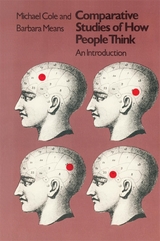 Comparative Studies of How People Think: An Introduction
Michael Cole and Barbara Means
Harvard University Press, 1981 The psychology of thinking has traditionally been in the business of making comparisons between different groups of people. On the whole, these comparisons have rendered a substantial body of knowledge; but all too often, they have suffered the pitfalls of faulty organizational logic and unfounded or invidious conclusions. In this extraordinarily clear and critical introduction, Michael Cole and Barbara Means out the problems involved in comparing how people think. They show, for example, how variables confounded with the constitution of two groups can lead to the wrong interpretation of group differences. More subtly, they demonstrate how cognitive differences between groups can destroy the equivalence of the tests used to make comparisons. They also discuss the unfortunate way that observed differences between groups have led to prejudicial interpretations in which mental differences are transformed into mental deficits.
Cole and Means illustrate all these problems with a rich variety of examples drawn from the research literature in comparative cognition. Because they use real examples. Cole and Means offer much more than the usual banal remedies for improving research design. Instead of merely telling the student to run the right control groups, for example, they show how theory enters into the selection of appropriate controls and how atheoretic comparative work can easily run amok.
It is a rare event when seasoned researchers take time to tell the novice how to avoid the problems of previous research. Comparative Studies of How People Think provides just such an event.
Comparing Apples, Oranges, and Cotton: Environmental Histories of the Global Plantation
Edited by Frank Uekötter
Campus Verlag, 2014 Worldwide, plantations are key economic institutions of the modern era. From an environmental perspective, they are also the settings for some of the most powerful, consequential, and frequently destructive modes of production ever to have existed. This volume assembles essays on commodities as diverse as coffee, cotton, rubber, apples, oranges, and tobacco, to provide an overview of plantation systems from Latin America to New Zealand that exposes the many dimensions of environmental history incorporated in these robust institutions. The global history of plantation systems not only highlights the great institutional resilience of our modern monocultures, but also the price that humans and environments have paid for them.
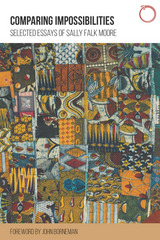 Comparing Impossibilities: Selected Essays of Sally Falk Moore
Sally Falk Moore
HAU, 2016 Few scholars have had a more varied career than Sally Falk Moore. Once a lawyer for an elite New York law firm, her career has led her to the Nuremberg trials where she prepared cases against major industrialists, to Harvard, to the Spanish archives where she studied the Inca political system, and to the mountain of Kilimanjaro where she studied the politics of Tanzanian socialism. This book offers a compelling tour of Moore’s diverse experiences, a history of her thought as she reflects on her life and thought in the disciplines of anthropology, law, and politics.
The essays range from studies of myths of incest and sexuality to those of economic development projects, from South America to Africa. The result is an astonishing assortment of works from one of the most respected legal anthropologists in the field, one who brought together disparate places and ideas in enriching comparisons that showcase the possibilities—and impossibilities—of anthropology.
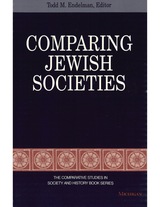 Comparing Jewish Societies
Todd M. Endelman, Editor
University of Michigan Press, 1997 Having unfolded in the diverse communities of the diaspora, Jewish experience lends itself almost effortlessly to comparative treatment. The contributors to this volume take up the challenge, examining Jewish societies from medieval to modern times, in Western and Eastern Europe, North and South America, North Africa, India, China, and the Middle East. The essays use the methodological strategies and theoretical insights of history, sociology, anthropology, and political science to explore such topics as Jewish and African nationalism; Arab and Jewish railway workers in British-ruled Palestine; East European Jewish immigrants in New York, London, and Paris; ritual murder trials in fin-de-siècle Central Europe; and Catholic and Jewish enlightenment movements. Further, because of their comparative structure and method, these essays stimulate fresh questions about the larger societies in which Jews lived--their values, practices, and structures. Comparing Jewish Societies will appeal to students and scholars at all levels who wish to break out of old frameworks to observe the Jews and their religion with a new, methodologically sophisticated eye. Todd M. Endelman is William Haber Professor of Modern Jewish History, University of Michigan.
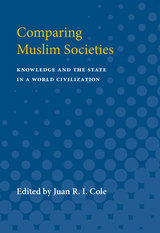 Comparing Muslim Societies: Knowledge and the State in a World Civilization
Juan R. I. Cole, Editor
University of Michigan Press, 1992 This book departs from stereotypes that often dominate Western discourse about Muslim societies. The Muslim world encompasses a wide range of countries—among them Turkey, Iraq, Egypt, Senegal, Saudi Arabia, and Morocco—each with a varying degree of religious stricture. Generalizations, therefore, can be erroneous and misleading. The contributors to this book—prominent scholars in anthropology, history, sociology, and political science—examine such issues as the ideology and political practices of Iran's ruling Shi'ite clerics, the impact of state policies on the status of women, the controversy over parliamentary government in the Arab world, the role of modern intellectuals, and charisma and leadership in tribal societies. The arguments the authors put forward often overturn conventional opinion about the Muslim world.This original and important book reminds us that Muslim society is not a monolith, but that it encompasses a rich variety of cultures.
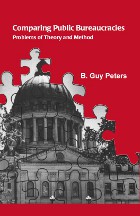 Comparing Public Bureaucracies: Problems of Theory and Method
B. Guy Peters
University of Alabama Press, 1988 A foundational guide to understanding how bureaucracies differ—and why those differences matter. The comparative study of public policy once promised to make major contributions to our understanding of government. Much of that promise now appears unfulfilled. What accounts for this decline in intellectual fortunes and change in intellectual fashion? Comparing Public Bureaucracies seeks to understand why. One of the principal answers is that there is no readily accepted and dependent variable that would allow comparative public administration to conform to the usual canons of social research. In contrast, comparative public policy has a ready-made dependent variable in public expenditure. Peters discusses four possible dependent variables for comparative public administration. The first is personnel—the number and type of people who work for government. Second, the number and type of organizations that form government can suggest a great deal about the structure of government. Third, the behavior of members is obviously important for understanding what actually happens in government—such as the extents to which bureaucracies approximate the budget-maximizing behavior posited by economists. Ginally, the relative power of civil servants in the policymaking process is a major factor in institutional politics in contemporary industrial societies.
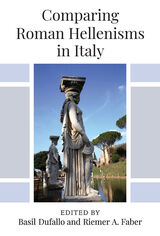 Comparing Roman Hellenisms in Italy
Edited by Basil Dufallo and Riemer A. Faber
University of Michigan Press, 2023 The story of Roman Hellenism—defined as the imitation or adoption of something Greek by those subject to or operating under Roman power—begins not with Roman incursions into the Greek mainland, but in Italy, where our most plentiful and spectacular surviving evidence is concentrated. Think of the architecture of the Roman capital, the Campanian towns of Pompeii and Herculaneum buried by Vesuvius, and the Hellenic culture of the Etruscans. Perhaps “everybody knows” that Rome adapted Greek culture in a steadily more “sophisticated” way as its prosperity and might increased. This volume, however, argues that the assumption of smooth continuity, let alone steady “improvement,” in any aspect of Roman Hellenism can blind us to important aspects of what Roman Hellenism really is and how it functions in a given context. As the first book to focus on the comparison of Roman Hellenisms per se, Comparing Roman Hellenisms in Italy shows that such comparison is especially valuable in revealing how any singular instance of the phenomenon is situated and specific, and has its own life, trajectory, circumstances, and afterlife. Roman Hellenism is always a work in progress, is often strategic, often falls prey to being forgotten, decontextualized, or reread in later periods, and thus is in important senses contingent. Further, what we may broadly identify as a Roman Hellenism need not imply Rome as the only center of influence. Roman Hellenism is often decentralized, and depends strongly on local agents, aesthetics, and materials. With this in mind, the essays concentrate geographically on Italy to lend both focus and breadth to our topic, as well as to emphasize the complex interrelation of Hellenism at Rome with Rome’s surroundings. Because Hellenism, whether as practiced by Romans or Rome’s subjects, is in fact widely diffused across far-flung geographical regions, the final part of the collection gestures to this broader context.
Compass and Clock: Poems
David Sanders
Ohio University Press, 2016 The poems of Compass and Clock take their inspiration from the intersection of the natural world and the human, exploring the landscapes in which those intersections occur. Those landscapes range from David Sanders’s native midwestern countryside to the caves of Lascaux and an enchanted lake where relics of lost lives are washed ashore. Yet, the true source of the poems’ vitality is Sanders’s attention to the missed or misread moments, those times when the act fails, and the perceived clashes with the actual. Here, the satisfying pairing of elegance and vulnerability invites the reader to tour those uncanny landscapes from which one returns irrevocably changed—refreshed, but wistful. In a review of his earlier limited-edition work, Time in Transit, the Hudson Review called David Sanders “a poet to watch.” With the Swallow Press publication of Compass and Clock, we have the realization of that promise.
Compass and Gyroscope: Integrating Science And Politics For The Environment
Kai N. Lee; Foreword by Phillip Shabecoff
Island Press, 1993 Using the Columbia River Basin in the Pacific Northwest as a case study, Kai Lee describes the concept and practice of "adaptive management," as he examines the successes and failures of past and present management experiences. Throughout the book, the author delves deeply into the theoretical framework behind the real-world experience, exploring how theories of science, politics, and cognitive psychology can be integrated into environmental management plans to increase their effectiveness.
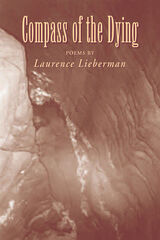 Compass of the Dying: Poems
Laurence Lieberman
University of Arkansas Press, 1998 When Laurence Lieberman writes of Guyana or islands in the Dutch West Indies, he excavates, explores, even exhumes the essence of the place. In the flora and fauna, in the rural cafes and ruins of churches and crypts, in the taste of iguana soup and the look of light through stained glass, Lieberman unfolds an exquisite atlas of the senses. The awe of encounter, the raw impact, beauty, and sometimes the brutality of both the surroundings and the people fuel this poetry. Whether he meets an iguana hunter, a bricklayer, a witness to the United States–led Grenada invasion, or a classical composer, Lieberman gives the reader a vivid combination of his own wit and surprising observations mingled with the speech of each character. Folk tales, legends, and island myths play a great role in his newest work. In the eddies of a river in Guyana, Lieberman dares river demons. On the island of Aruba, he hears the chants and work songs of long-dead miners in an abandoned gold mine. He briefly loses himself when he stares into the mirror of a well once frequented by slaves on Bonaire. Coupled with natural forces—floods, volcanic eruptions, constant rains—these folk tales and the stories of the islanders’ lives create a “wedding of sun and rain,” and a map to the troves of the Caribbean hidden beneath a rich and often violent history.
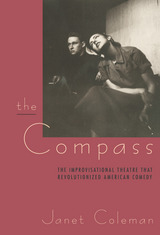 The Compass: The Improvisational Theatre that Revolutionized American Comedy
Janet Coleman
University of Chicago Press, 1991 Janet Coleman brilliantly recreates the time, the place, the personalities, and the neurotic magic whereby the Compass made theater history in America. The Compass began in a storefront theater near the University of Chicago campus in the summer of 1955 and lasted only a few years before its players—including David Shepherd, Paul Sills, Elaine May, Mike Nichols, Barbara Harris, and Shelley Berman—moved on. Out of this group was born a new form: improvisational theater and a radically new kind of comedian. "They did not plan to be funny or to change the course of comedy," writes Coleman. "But that is what happened."
"For anyone who is interested in theatre, underground theatre, improvisational theatre, and the sheer madness of trying something new with a repertory group, The Compass will prove a welcome history with fascinating details."—Norman Mailer
"Janet Coleman has done a spectacular job of capturing the history, the almost alarmingly diverse cultural influences, and the extraordinary people who made up the Compass."—Neal Weaver, Los Angeles Village View
"Engrossing. . . . An open window on a part of the theater that should be known."—Arthur Miller
"A valuable chronicle of an important chapter in the history of comedy and theater."—William Wolf, New York Observer
"The eruptive, disruptive talents who made the theater memorable are the same ones who make The Compass a good read."—Jay Cocks, Time
"A moving, inspirational, anecdote-studded feast."—Publishers Weekly
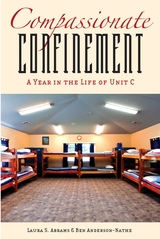 Compassionate Confinement: A Year in the Life of Unit C
Abrams, Laura S.
Rutgers University Press, 2013 Received an Honorable Mention for the 2015 Society for Social Work and Research Outstanding Social Work Book Award
To date, knowledge of the everyday world of the juvenile correction institution has been extremely sparse. Compassionate Confinement brings to light the challenges and complexities inherent in the U.S. system of juvenile corrections. Building on over a year of field work at a boys’ residential facility, Laura S. Abrams and Ben Anderson-Nathe provide a context for contemporary institutions and highlight some of the system’s most troubling tensions.
This ethnographic text utilizes narratives, observations, and case examples to illustrate the strain between treatment and correctional paradigms and the mixed messages regarding gender identity and masculinity that the youths are expected to navigate. Within this context, the authors use the boys’ stories to show various and unexpected pathways toward behavior change. While some residents clearly seized opportunities for self-transformation, others manipulated their way toward release, and faced substantial challenges when they returned home. Compassionate Confinement concludes with recommendations for rehabilitating this notoriously troubled system in light of the experiences of its most vulnerable stakeholders.
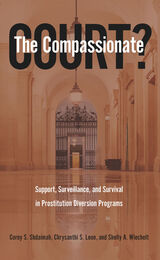 The Compassionate Court?: Support, Surveillance, and Survival in Prostitution Diversion Programs
Corey S. Shdaimah, Chrysanthi S. Leon, and Shelly A. Wiechelt
Temple University Press, 2023 Laws subject people who perform sex work to arrest and prosecution. The Compassionate Court? assesses two prostitution diversion programs (PDPs) that offer to “rehabilitate” people arrested for street-based sex work as an alternative to incarceration. However, as the authors show, these PDPs often fail to provide sustainable alternatives to their mandated clients. Participants are subjected to constant surveillance and obligations, which creates a paradox of responsibility in conflict with the system’s logic of rescue. Moreover, as the participants often face shame and re-traumatization as a price for services, poverty and other social problems, such as structural oppression, remain in place.
The authors of The Compassionate Court? provide case studies of such programs and draw upon interviews and observations conducted over a decade to reveal how participants and professionals perceive court-affiliated PDPs, clients, and staff. Considering the motivations, vision, and goals of these programs as well as their limitations—the inequity and disempowerment of their participants—the authors also present their own changing perspectives on prostitution courts, diversion programs, and criminalization of sex work.
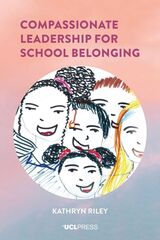 Compassionate Leadership for School Belonging
Kathryn Riley
University College London, 2022 A highly readable book offering a message of hope for education in an uncertain world.
Compassionate Leadership for School Belonging draws on forty years of international research and professional practice to show how schools can be places of safety and fulfillment, even in the most difficult of circumstances. When belonging is a school’s guiding principle, more young people experience a sense of connectedness and friendship, perform better academically, and come to believe in themselves; their teachers feel more professionally fulfilled, their families more accepted. The originality of this highly readable book lies in its scope. It offers international analysis from the OECD alongside insights from the author’s extensive research in schools, powerfully supported by observational vignettes and drawings from the children, young people, and teachers who have been her co-researchers. The book reveals patterns of dislocation, disaffection, and exclusion, and highlights the points of intervention in policy and practice needed across school systems to create the conditions for school belonging. The methodologies, concepts, and research tools offered can be used by practitioners and researchers in their own contexts and to guide school leaders towards creating their own places of belonging.
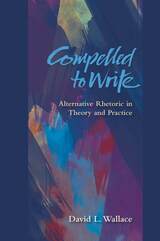 Compelled to Write: Alternative Rhetoric in Theory and Practice
David L. Wallace
Utah State University Press, 2011 David Wallace argues that any understanding of writing studies must include the conception of discourse as an embodied force with real consequences for real people. Informed in important ways by queer theory, Wallace calls to account users of dominant discourses and at the same time articulates a theory base from which to interpret "alternative rhetoric." To examine the practice of writing from varied margins of society, Compelled to Write offers careful readings of four exemplar American writers, each of whom felt compelled within their own time and place to write in response to systemic injustices in American society. Sarah Grimké, a privileged white woman advocating for abolition, is forced to defend her right to speak as a woman; Frederick Douglass begins his public career almost as a curiosity (the articulate ex-slave) and ends it as one of the most important rhetors in American history; Gloria Anzaldúa writes not only in multiple languages and dialects but from marginalized positions related to gender, race, class, sexual identity, and physical abled-ness; David Sedaris uses his privileged position as a middle-class white male humorist to speak unabashedly of his sexuality, his addictions, and obsessive-compulsive personality disorder. Through these writers, Wallace explores a range of strategies that comprise alternative rhetorical practice, and demonstrates how such practice is inflected by social constraints on rhetorical agency and by how writers employ alternative discourses to resist those constraints. Grounding and personalizing Compelled to Write with rich material from his own teaching and his own experience, Wallace considers a number of implications for teachers of writing.
Compelling Belief: The Culture of American Schooling
Stephen Arons
University of Massachusetts Press, 1986 This book is about the stifling of dissent by an institution widely acclaimed as the bulwark of democracy in America. It may be no surprise to late twentieth-century cynics that institutions eventually destroy goals they were meant to achieve; but it is nevertheless a paradox that a society should repress intellectual freedom with the institution of education.
 The Compelling Image: Nature and Style in Seventeenth-Century Chinese Painting
James Cahill
Harvard University Press, 1982 The Compelling Image will delight the art-lover who does not yet realize that Chinese painting can be as original and moving as El Greco or Cézanne. With a graceful authority, James Cahill explores the radiant painting of that tumultuous era when the collapse of the Ming Dynasty and the Manchu conquest of China dramatically changed the lives and thinking of artists and intellectuals.
The brilliant masters of the seventeenth century were reconsidering their artistic relationship to nature and to the painting of earlier times, while European pictorial arts introduced by Jesuit missionaries were profoundly influencing Chinese techniques. The reader/viewer is presented with a series of crucial distinctions of style and approach in a richly illustrated book that illuminates the whole character of Chinese painting.
Cahill begins with a relatively neglected artist, Chang Hung, who moved traditional forms ever closer to literal descriptions of nature, in contrast with the theorist painter Tung Ch’i-ch’ang, who turned the same traditional forms into powerful abstractions. A chapter focused on Wu Pin offers new and controversial ideas about the impact of European art, as well as a related phenomenon: revival of the highly descriptive early Sung styles. Looking especially at Ch’en Hung-shou, the greatest of the late Ming figure painters, Cahill examines a curious mixing of real people and conventionally rendered surroundings in portrait art of the period. He analyzes the expressionist experiments of the masters known as Individualists, and distinguishes these artists from the Orthodox school, concluding with a bold reassessment of the most eloquent of later Chinese painters, Tao-chi.
Over 250 illustrations, including twelve color plates, are drawn from collections in the United States, Europe, Japan, and China. This is a book for anyone interested in China, its past, and its art, and for the enthusiast who wishes to broaden the horizons of enjoyment by exposure to a most engaging writer on an exquisite era.
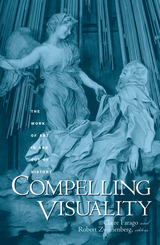 Compelling Visuality: The Work Of Art In And Out Of History
Claire Farago
University of Minnesota Press, 2003 Explores what we actually see, touch, and experience when looking at art Typically, art history is an enterprise of recovery—of searching out the provenance, the original intentions, the physical setting, and historical conditions behind a work of art. The essays in Compelling Visuality address some of the other questions that are less frequently asked—and, in doing so, show how much is to be learned and gained by going beyond the traditional approaches of art history. In particular, the contributors take up the commonly unexplored question of what is actually present in a work of art—what we see, touch, and experience when confronted with Renaissance or Baroque works that have survived the vicissitudes of time. International and interdisciplinary, this volume conducts readers into an ongoing discussion of the value and significance of personal response to works of art. Contributors: F. R. Ankersmit, U of Groningen; Mieke Bal, U of Amsterdam and Cornell U; Oskar Bätschmann, U of Bern; Georges Didi-Huberman, École des Hautes Études en Sciences Sociales, Paris; Michael Ann Holly, Clark Art Institute; Donald Preziosi, UCLA and Oxford U; Renée van de Vall, U of Maastricht.
Compendium: A Collection of Thoughts on Prosody
Donald Justice
Omnidawn, 2017 Justice’s insights serve as a sort of de facto taxonomy, an organically designed system that he uses to present his lecture on each respective aspect of the evolution of poetic form. There is no formal thesis here, but rather a kind of scrapbook that has a broader motive. The material possesses no hidden secrets; the treasures lie in plain sight and simply need be discerned to open the artist’s mind to their possibilities.
 Compendium of General Sociology
Vilfredo Pareto
University of Minnesota Press, 1980 Compendium of General Sociology was first published in 1980. Minnesota Archive Editions uses digital technology to make long-unavailable books once again accessible, and are published unaltered from the original University of Minnesota Press editions.Vilfredo Pareto (1848-1923) was a social scientist who plated a significant role in the development of sociology, economics, and political science. Society, to Pareto, was governed principally by non-rational forces, and he was critical of all rational explanations and ideologies. He contributed to the development of functionalist and systems theories of social and economic life and was a major influence on the work of talcott Parsons. He was also and advocate of empirical and experimental methods in the social sciences as well as of mathematical sociology and economics.Pareto’s classic work, the Trattato di Sociologia Generale (1916), was published by his student Giulio Farina in 1920. Farina was able to rely upon Pareto for corrections and approval of the abridgement. Now, for the first time, this abridged work is available in an English translation, as the Compendium of General Sociology. Elisabeth Abbott participated in the Livingston-Bongiorno translation of the complete Trattato in the 1930s, and she has drawn upon that notable translation (now out of print) in her work on the Compendium. A substantial introduction by sociologist Joseoh Lopreato of the University of Texas provides a historical context for Pareto’s work and calls attention to the main lines in his thought.
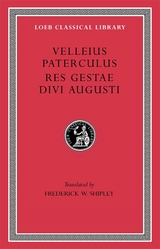 Compendium of Roman History. Res Gestae Divi Augusti
Velleius Paterculus
Harvard University Press An imperial historian and an emperor’s history.
Velleius Paterculus, who lived in the reigns of Augustus and Tiberius (30 BC–AD 37), served as a military tribune in Thrace, Macedonia, Greece, and Asia Minor, and later, from AD 4 to 12 or 13, as a cavalry officer and legatus in Germany and Pannonia. He was quaestor in AD 7, praetor in 15. He wrote in two books “Roman Histories,” a summary of Roman history from the fall of Troy to AD 29. As he approached his own times he becomes much fuller in his treatment, especially between the death of Caesar in 44 BC and that of Augustus in AD 14. His work has useful concise essays on Roman colonies and provinces and some effective compressed portrayals of characters.
Res Gestae Divi Augusti. In his 76th year (AD 13–14) the emperor Augustus wrote a dignified account of his public life and work of which the best preserved copy (with a Greek translation) was engraved by the Galatians on the walls of the temple of Augustus at Ancyra (Ankara). It is a unique document giving short details of his public offices and honors; his benefactions to the empire, to the people, and to the soldiers; and his services as a soldier and as an administrator.
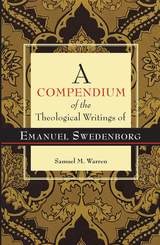 A Compendium of the Theological Writings of Emanuel Swedenborg
SAMUEL WARREN
Swedenborg Foundation Publishers, 2009
In his lifetime, Swedish scientist and theologian Emanuel Swedenborg published more than seven thousand pages of commentary based on his communication with the spiritual world. A Compendium of the Theological Writings of Emanuel Swedenborg extracts key passages from this astounding body of work and groups them by subject for easy reference.
Starting with the nature of God and creation, the book covers the birth of humanity and gives a thorough overview of Swedenborg’s five churches, or the five ages of human history as understood spiritually. It includes sections on concepts that are central to Swedenborg’s thought, such as regeneration, correspondences, faith, charity, free will, and marriage, as well as more universal questions: how God is present in our lives, why evil exists in the world, the nature of the human soul, and how we are connected to the divine on a deep inner level. The final quarter of the book is devoted to Swedenborg’s most popular subject—the nature of the afterlife, including heaven, hell, and the world of spirits.
Originally compiled in 1875, this volume remains an important research tool for anyone who wants an overview of Swedenborg’s theology or a springboard for investigating his thought in depth.
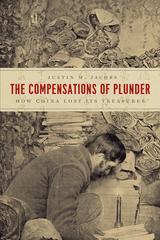 The Compensations of Plunder: How China Lost Its Treasures
Justin M. Jacobs
University of Chicago Press, 2020 From the 1790s until World War I, Western museums filled their shelves with art and antiquities from around the world. These objects are now widely regarded as stolen from their countries of origin, and demands for their repatriation grow louder by the day. In The Compensations of Plunder, Justin M. Jacobs brings to light the historical context of the exodus of cultural treasures from northwestern China. Based on a close analysis of previously neglected archives in English, French, and Chinese, Jacobs finds that many local elites in China acquiesced to the removal of art and antiquities abroad, understanding their trade as currency for a cosmopolitan elite. In the decades after the 1911 Revolution, however, these antiquities went from being “diplomatic capital” to disputed icons of the emerging nation-state. A new generation of Chinese scholars began to criminalize the prior activities of archaeologists, erasing all memory of the pragmatic barter relationship that once existed in China. Recovering the voices of those local officials, scholars, and laborers who shaped the global trade in antiquities, The Compensations of Plunder brings historical grounding to a highly contentious topic in modern Chinese history and informs heated debates over cultural restitution throughout the world.
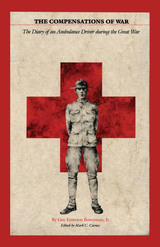 The Compensations of War: The Diary of an Ambulance Driver during the Great War
By Guy Emerson Bowerman
University of Texas Press, 1983 In 1917, shortly after the United States’ declaration of war on Germany, Guy Emerson Bowerman, Jr., enlisted in the American army’s ambulance service. Like other young ambulance drivers—Hemingway, Dos Passos, Cummings, Cowley—Bowerman longed to “see the show.” He was glad to learn that the ambulance units were leaving for France right away. For seventeen months, until the armistice of November 1918, Bowerman kept an almost daily diary of the war. To read his words today is to live the war with an immediacy and vividness of detail that is astonishing. Only twenty when he enlisted, Bowerman was an idealistic, if snobbish, young man who exulted that his section was made up mostly of young “Yalies” like himself. But he expected the war to change him, and it did. In the end he writes that he and his compatriots scarcely remember a world at peace. "The old life was gone forever. . ." Guy Bowerman’s unit was attached to a French infantry division stationed near Verdun. Sent to halt the German drive to Paris in 1918, the division participated in the decisive counterattack of July and tracked the routed Germans through Belgium. Then, “unwarned,” Bowerman and his comrades were “plunged into … a life of peace.” Into this life, he writes, they walked “bewildered,” like “men fearing ambush.” This remarkable chronicle of one young man’s rite of passage is destined to become a classic in the literature of the Great War.
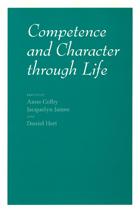 Competence and Character through Life
Edited by Anne Colby, Jacquelyn Boone James, and Daniel Hart
University of Chicago Press, 1998 Competence and character are at the heart of our notions of a mature and successful adult, yet many questions about their nature and development remain unanswered.
In this collection, leading psychologists, sociologists, and criminologists highlight the potential for positive development in different domains. By positing the possibility of multiple pathways of development rather than a single universal sequence, the contributors view the individual as potentially advancing in a wide range of interrelated and overlapping competencies. The nine essays in the book cover the years from youth to middle age, and they examine a range of social, political, and moral components of "competence and character" from teenage pregnancy and life-planning skills to voting records and educational attainment in low income households. Unlike comparable studies, this original and comprehensive volume frames issues, events, and longitudinal data through the lens of possibility rather than the pathology of defeat, stressing a positive approach to our conception of human potential.
 Competence to Consent
Becky Cox White
Georgetown University Press, 1994 Free and informed consent is one of the most widespread and morally important practices of modern health care; competence to consent is its cornerstone. In this book, Becky Cox White provides a concise introduction to the key practical, philosophical, and moral issues involved in competence to consent. The goals of informed consent, respect for patient autonomy and provision of beneficent care, cannot be met without a competent patient. Thus determining a patient's competence is the critical first step to informed consent. Determining competence depends on defining it, yet surprisingly, no widely accepted definition of competence exists. White identifies nine capacities that patients must exhibit to be competent. She approaches the problem from the task-oriented nature of decision making and focuses on the problems of defining competence within clinical practice. Her proposed definition is based on understanding competence as occurring in a special rather than a general context; as occurring in degrees rather than at a precise threshold; as independent of consequential appeals; and as incorporating affective as well as cognitive capacities. Combining both an ethical overview and practical guidelines, this book will be of value to health care professionals, bioethicists, and lawyers.
 Competency-Based Career Planning for Reference and User Services Professionals
Jo Bell Whitlatch
American Library Association, 2020 Reference and user services librarians need to be in charge of their own careers. And when it comes to their own professional development, that means being proactive. This resource will enable professionals at every stage of their careers to honestly assess their skills and knowledge. Utilizing the RUSA (Reference and User Services Association) Professional Competencies as a framework for reflecting on strengths as well as gaps in expertise, it guides readers through developing strategies to enhance their professional standing and potential, thereby leading to a more satisfying career. In this book former RUSA president Whitlatch, who chaired the initial committee establishing the Competencies, teams up with expert trainer Woodard to - introduce the seven categories of the RUSA Professional Competencies, explaining the ways in which each is important to both practitioner and institution;
- demonstrate how to create a personal development plan that focuses on development priorities;
- discuss the Association for Talent Development (ATD) Competency Development Model and other action plans;
- offer guidance for setting goals and measuring progress;
- share information on a variety of development activities that readers can undertake to maintain and enhance professional competencies, including formal training opportunities, on-the-job experiences, and self-directed initiatives; and
- provide recommended self-evaluation techniques such as writing up notes from group discussions, exercises, short verbal and written reports, crafting presentations on a topic, and sharing concrete examples of how skills were applied in the workplace.
 Competing Devotions: Career and Family among Women Executives
Mary Blair-Loy
Harvard University Press, 2005 The wrenching decision facing successful women choosing between demanding careers and intensive family lives has been the subject of many articles and books, most of which propose strategies for resolving the dilemma. Competing Devotions focuses on broader social and cultural forces that create women's identities and shape their understanding of what makes life worth living.
Mary Blair-Loy examines the career paths of women financial executives who have tried various approaches to balancing career and family. The professional level these women have attained requires a huge commitment of time, energy, and emotion that seems natural to employers and clients, who assume that a career deserves single-minded allegiance. Meanwhile, these women must confront the cultural model of family that defines marriage and motherhood as a woman's primary vocation. This ideal promises women creativity, intimacy, and financial stability in caring for a family. It defines children as fragile and assumes that men lack the selflessness and patience that children's primary caregivers need. This ideal is taken for granted in much of contemporary society.
The power of these assumptions is enormous but not absolute. Competing Devotions identifies women executives who try to reshape these ideas. These mavericks, who face great resistance but are aided by new ideological and material resources that come with historical change, may eventually redefine both the nuclear family and the capitalist firm in ways that reduce work-family conflict.
Competing Discourses: Orthodoxy, Authenticity, and Engendered Meanings in Late Imperial Chinese Fiction
Maram Epstein
Harvard University Press, 2001 In the traditional Chinese symbolic vocabulary, the construction of gender was never far from debates about ritual propriety, desire, and even cosmic harmony. Competing Discourses maps the aesthetic and semantic meanings associated with gender in the Ming-Qing vernacular novel through close readings of five long narratives: Marriage Bonds to Awaken the World, Dream of the Red Chamber, A Country Codger's Words of Exposure, Flowers in the Mirror, and A Tale of Heroic Lovers.
Epstein argues that the authors of these novels manipulated gendered terms to achieve structural coherence. These patterns are, however, frequently at odds with other gendered structures in the texts, and authors exploited these conflicts to discuss the problem of orthodox behavior versus the cult of feeling.
 Competing for Capital: Europe and North America in a Global Era
Kenneth P. Thomas
Georgetown University Press, 2000 As corporations search for new production sites, governments compete furiously using location subsidies and tax incentives to lure them. Yet underwriting big business can have its costs: reduction in economic efficiency, shifting of tax burdens, worsening of economic inequalities, or environmental degradation. Competing for Capital is one of the first books to analyze competition for investment in order to suggest ways of controlling the effects of capital mobility. Comparing the European Union's strict regulation of state aid to business with the virtually unregulated investment competition in the United States and Canada, Kenneth P. Thomas documents Europe's relative success in controlling—and decreasing—subsidies to business, even while they rise in the United States. Thomas provides an extensive history of the powers granted to the EU's governing European Commission for controlling subsidies and draws on data to show that those efforts are paying off. In reviewing trends in North America, he offers the first comprehensive estimate of U.S. subsidies to business at all levels to show that the United States is a much higher subsidizer than it portrays itself as being. Thomas then suggests what we might learn from the European experience to control the effects of capital mobility—not only within or between states, but also globally, within NAFTA and the World Trade Organization as well. He concludes with policy recommendations to help promote international cooperation and cross-fertilization of ways to control competition for investment.
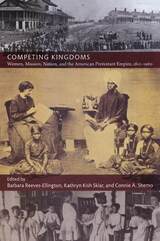 Competing Kingdoms: Women, Mission, Nation, and the American Protestant Empire, 1812–1960
Barbara Reeves-Ellington, Kathryn Kish Sklar, and Connie A. Shemo, eds.
Duke University Press, 2010 Competing Kingdoms rethinks the importance of women and religion within U.S. imperial culture from the early nineteenth century to the mid-twentieth. In an era when the United States was emerging as a world power to challenge the hegemony of European imperial powers, American women missionaries strove to create a new Kingdom of God. They did much to shape a Protestant empire based on American values and institutions. This book examines American women’s activism in a broad transnational context. It offers a complex array of engagements with their efforts to provide rich intercultural histories about the global expansion of American culture and American Protestantism. An international and interdisciplinary group of scholars, the contributors bring under-utilized evidence from U.S. and non-U.S. sources to bear on the study of American women missionaries abroad and at home. Focusing on women from several denominations, they build on the insights of postcolonial scholarship to incorporate the agency of the people among whom missionaries lived. They explore how people in China, the Congo Free State, Egypt, India, Japan, Ndebeleland (colonial Rhodesia), Ottoman Bulgaria, and the Philippines perceived, experienced, and negotiated American cultural expansion. They also consider missionary work among people within the United States who were constructed as foreign, including African Americans, Native Americans, and Chinese immigrants. By presenting multiple cultural perspectives, this important collection challenges simplistic notions about missionary cultural imperialism, revealing the complexity of American missionary attitudes toward race and the ways that ideas of domesticity were reworked and appropriated in various settings. It expands the field of U.S. women’s history into the international arena, increases understanding of the global spread of American culture, and offers new concepts for analyzing the history of American empire. Contributors: Beth Baron, Betty Bergland, Mary Kupiec Cayton, Derek Chang, Sue Gronewold, Jane Hunter, Sylvia Jacobs, Susan Haskell Khan, Rui Kohiyama, Laura Prieto, Barbara Reeves-Ellington, Mary Renda, Connie A. Shemo, Kathryn Kish Sklar, Ian Tyrrell, Wendy Urban-Mead
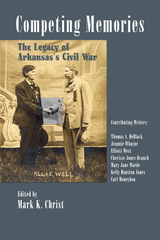 Competing Memories: The Legacy of Arkansas's Civil War
Mark Christ
Butler Center for Arkansas Studies, 2016 Between 2011 and 2015, Arkansas commemorated the 150th anniversary of the American Civil War with re-enactments, lectures, placement of historical markers, and a wide variety of other events that were collectively attended by more than 375,000 people. While the sesquicentennial commemoration highlighted the Civil War events that occurred in the state and honored the people who experienced the war in Arkansas, the question of the war’s significance to modern Arkansas remained. Competing Memories: The Legacy of Arkansas’s Civil War collects the proceedings of the final seminar sponsored by the Arkansas Civil War Sesquicentennial Commission, which sought to define the lasting impact that the nation’s deadliest conflict had on the state by bringing together some of the state’s leading historians. In these essays, Thomas A. DeBlack explores the post-war lives of both Union and Confederate soldiers who played prominent roles in Civil War Arkansas. Cherisse Jones-Branch delves into the lives of black Arkansans during the war and Reconstruction. Jeannie Whayne discusses the many ways the Civil War affected the state’s economic development, while Kelly Houston Jones investigates the Civil War’s impact on Arkansas women. Mary Jane Warde examines the devastating effects of the Civil War on Native Americans in Arkansas and the Indian Territory. Elliott West scrutinizes Civil War Arkansas from a continental perspective, and Carl Moneyhon considers the evolution of how we remember the Civil War. Together, the essays in Competing Memories: The Legacy of Arkansas’s Civil War provide a compelling account of how America’s bloodiest war continues to affect Arkansas and its people today.
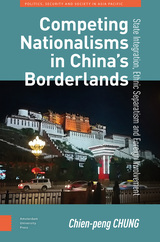 Competing Nationalisms in China’s Borderlands: State Integration, Ethnic Separatism and Foreign Involvement
Chien-peng Chung
Amsterdam University Press, 2025 This book endeavors to provide a balanced analytical treatment of ethnic nationalists, state leaders, and foreign intervenors in China’s frontier politics, explaining systematically the circumstances of their entanglements, and traces in detail the underlying and lasting causes and effects of their association—from the closing years of the last Chinese imperial dynasty in the late nineteenth century to the present day.
Structured chronologically, the book offers in-depth analysis, comprehensively covering more than a hundred years of ethnic separatism, governance, and interventionism in the modern political history of China, using Tibetan, Uyghur, and Inner Mongolian case studies with a theoretical framework of internal colonialism/state integration.
Competing Nationalisms in China’s Borderlands is essential reading for students and instructors of undergraduate and graduate courses on China and acquisition for university and public libraries, and is also recommended for everyone else interested in China’s ethnic politics and its international dimensions.
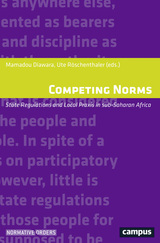 Competing Norms: State Regulations and Local Praxis in sub-Saharan Africa
Edited by Mamadou Diawara and Ute Röschenthaler
Campus Verlag, 2016 States in sub-Saharan Africa, as anywhere else, are vested with the authority to implement laws and sanction their application. But in spite of a growing emphasis in Africa on participatory approaches to legislation, little research has focused on the extent to which the public has become involved in policy making and whether the state regulations that have been produced have proven publicly beneficial. Offering a new anthropological perspective, Competing Norms fills that gap by exploring how people in sub-Saharan Africa view new regulations in the light of preexisting local norms with which new regulations often compete. A collection of international, interdisciplinary contributors discusses the competing local, state, and international norms as they have evolved over time, unfolding the intricate ambivalences and contradictions that often characterize state regulations.
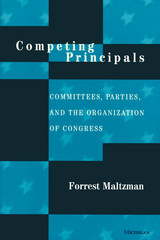 Competing Principals: Committees, Parties, and the Organization of Congress
Forrest Maltzman
University of Michigan Press, 1998 Since Woodrow Wilson, political scientists have recognized the importance of congressional committees in the policy-making process. Congressional committees often determine what legislation will reach the floor of the House or Senate and what form that legislation will take. In spite of the broad consensus on the importance of congressional committees, there is little agreement on what explains committee action. Committees are alternately viewed as agents of the chamber, the party caucuses, or constituencies outside the institution. Each theory suggests a different distribution of power in the policy-making process.
Forrest Maltzman argues that none of these models fully captures the role performed by congressional committees and that committee members attempt to balance the interests of the chamber, the party caucus, and outside constituencies. Over time, and with the changing importance of a committee's agenda to these groups, the responsiveness of members of committees will vary. Maltzman argues that the responsiveness of the committee to these groups is driven by changes in procedure, the strength of the party caucus, and the salience of a committee's agenda. Maltzman tests his theory against historical data.
This book will appeal to social scientists interested in the study of Congress and legislative bodies, as well as those interested in studying the impact of institutional structure on the policy-making process.
"This specialized study, of value to congressional scholars and partisan activists, enriches an understanding of the increasingly predictable patterns of committee variety." --Choice
Forrest Maltzman is Assistant Professor of Political Science, George Washington University.
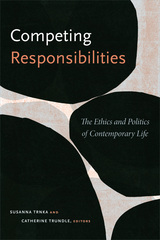 Competing Responsibilities: The Ethics and Politics of Contemporary Life
Susanna Trnka and Catherine Trundle, editors
Duke University Press, 2017 Noting the pervasiveness of the adoption of "responsibility" as a core ideal of neoliberal governance, the contributors to Competing Responsibilities challenge contemporary understandings and critiques of that concept in political, social, and ethical life. They reveal that neoliberalism's reification of the responsible subject masks the myriad forms of individual and collective responsibility that people engage with in their everyday lives, from accountability, self-sufficiency, and prudence to care, obligation, and culpability. The essays—which combine social theory with ethnographic research from Europe, North America, Africa, and New Zealand—address a wide range of topics, including critiques of corporate social responsibility practices; the relationships between public and private responsibilities in the context of state violence; the tension between calls on individuals and imperatives to groups to prevent the transmission of HIV; audit culture; and how health is cast as a citizenship issue. Competing Responsibilities allows for the examination of modes of responsibility that extend, challenge, or coexist with the neoliberal focus on the individual cultivation of the self.
Contributors
Barry D. Adam, Elizabeth Anne Davis, Filippa Lentzos, Jessica Robbins-Ruszkowski, Nikolas Rose, Rosalind Shaw, Cris Shore, Jessica M. Smith, Susanna Trnka, Catherine Trundle, Jarrett Zigon
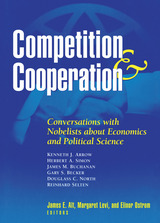 Competition and Cooperation: Conversations with Nobelists about Economics and Political Science
James Alt
Russell Sage Foundation, 1999 What can the disciplines of political science and economics learn from one another? Political scientists have recently begun to adapt economic theories of exchange, trade, and competition to the study of legislatures, parties, and voting. At the same time, some of the most innovative and influential thinkers in economics have crossed the boundaries of their discipline to explore the classic questions of political science. Competition and Cooperation features six of these path-breaking scholars, all winners of the Nobel Prize for Economics, in a series of conversations with more than a dozen distinguished political scientists. The discussions analyze, adapt, and extend the Nobelists' seminal work, showing how it has carried over into political science and paved the way for fruitful cooperation between the two disciplines. The exchanges span all of the major conceptual legacies of the Nobel laureates: Arrow's formalization of the problems of collective decisions; Buchanan's work on constitutions and his critique of majority rule; Becker's theory of competition among interest groups; North's focus on insecure property rights and transaction costs; Simon's concern with the limits to rationality; and Selten's experimental work on strategic thinking and behavior. As befits any genuine dialogue, the traffic of ideas and experiences runs both ways. The Nobel economists have had a profound impact upon political science, but, in addressing political questions, they have also had to rethink many settled assumptions of economics. The standard image of economic man as a hyper-rational, self-interested creature, acting by and for for himself, bears only a passing resemblance to man as a political animal. Several of the Nobelists featured in this volume have turned instead to the insights of cognitive science and institutional analysis to provide a more recognizable portrait of political life. The reconsideration of rationality and the role of institutions,in economics as in politics, raises the possibility of a shared approach to individual choice and institutional behavior that gives glimmers of a new unity in the social sciences. Competition and Cooperation demonstrates that the most important work in both economics and political science reflects a marriage of the two disciplines.
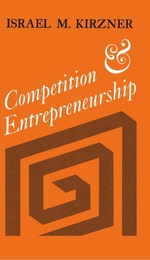 Competition and Entrepreneurship
Israel M. Kirzner
University of Chicago Press, 1978 Stressing verbal logic rather than mathematics, Israel M. Kirzner provides at once a thorough critique of contemporary price theory, an essay on the theory of entrepreneurship, and an essay on the theory of competition. Competition and Entrepreneurship offers a new appraisal of quality competition, of selling effort, and of the fundamental weaknesses of contemporary welfare economics.
Kirzner's book establishes a theory of the market and the price system which differs from orthodox price theory. He sees orthodox price theory as explaining the configuration of prices and quantities that satisfied the conditions for equilibrium. Mr. Kirzner argues that "it is more useful to look to price theory to help understand how the decisions of individual participants in the market interact to generate the market forces which compel changes in prices, outputs, and methods of production and in the allocation of resources."
Although Competition and Entrepreneurship is primarily concerned with the operation of the market economy, Kirzner's insights can be applied to crucial aspects of centrally planned economic systems as well. In the analysis of these processes, Kirzner clearly shows that the rediscovery of the entrepreneur must emerge as a step of major importance.
 Competition in an Open Economy: A Model Applied to Canada
Richard E. Caves, Michael E. Porter, A. Michael Spence, and John T. Scott
Harvard University Press, 1980 With the nations of the world becoming more interdependent, it is imperative to take international influences into account in understanding the organization of industry within a country. This book extends the structure/conduct/performance framework of analysis to present a fully specified simultaneous equation model of an open economy—Canada.
By estimating a system of equations of all the major variables, the authors can identify which variables are dependent and which are independent. They are thus able to assess the relative importance of such factors as seller concentration, import competition, retailing structure, advertising expenditure, research and development spending, and technical and allocative efficiency in shaping the organization of industry in Canada. In addition, using both industry-level and firm-level data, the authors develop methods for assessing the effect of structural variables on diversification strategies and the consequences for market performance. They also study the effects of such variables on firms’ access to capital markets. The book concludes with a discussion of the implications of the findings for government policy.
Competition in the Health Care Sector: Ten Years Later
Warren Greenberg, ed.
Duke University Press, 1988 “Competition. Deregulation. Free market forces. The debate over competition in health care that raged in the 1970s brought with it a new economic jargon, a vocabulary of concepts and issues unheard of in hospitals a decade earlier.
“Competition in health care has developed to a greater degree than most economists predicted ten years ago. That is the conclusion of Warren Greenberg in his introduction to Competition in the Health Care Sector: Ten Years Later, a retrospective of a 1977 Federal Trade Commission conference, which produced the landmark treatise Competition in the Health Care Sector: Past, Present, and Future. Seven of the ten original papers are reexamined; a chapter on the nursing home industry has been added.
“As with the original volume, Greenberg predicts that the retrospective will become a critical element in the health care economic literature.”—Hospitals
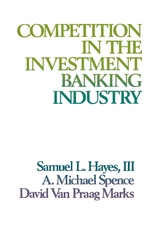 Competition in the Investment Banking Industry
Samuel L. Hayes, III; A. Michael Spence; and David Van Praag Marks
Harvard University Press, 1983 Investment banks play a critically important role in channeling capital from investors to corporations. Not only do they float and distribute new corporate securities, they also assist companies in the private placement of securities, arrange mergers and acquisitions, devise specialized financing, and provide other corporate financial services.
After sketching the history and evolution of investment banking, the authors describe the structure of the industry, focusing on the competitive forces at work within it today. They explore patterns of concentration and analyze the strategic and economic factors that underlie those patterns. The authors directly examine the pairing up of investment banks with their corporate clients. They show that the market is sharply segmented, with banks and corporate clients being matched in roughly rank order, the most prestigious banks with the largest, most powerful clients, and so on. Vigorous competition occurs within each segment, but much less between them.
With the industry now confronting a changing regulatory environment, a growing tendency of clients to arrange their own financing, and increasing competition both from within and from commercial banks and foreign institutions, Competition in the Investment Banking Industry is essential reading for anyone interested in the future of investment banking.
 Competition in the Midwestern Coal Industry
Reed Moyer
Harvard University Press In this vigorous and well-documented "current view" of competition in the mid-western coal industry, Reed Moyer has set himself two tasks: to bring up to date existing economic analyses and to correct a "distortion which arises from generalizing about an industry composed of several diverse parts."
Most previous economic analyses have become obsolete, partly because of the shifting picture within the industry. Moyer’s detailed study of the economic behavior of the midwestern coal industry focuses on the transformation in the mining operation. Contrary to popular opinion, the bituminous coal industry in the Midwest is not "chronically depressed"; instead, it is successfully surmounting years of stagnation dating back to the 1920s, the effects of strikes, and the stiff competition offered coal by other fuels in the recent past. Concerned primarily with the coal producing regions of Illinois, Indiana, and western Kentucky, the author considers not only the economic factors touching the industry, but the geologic and geographic as well. In a framework of market structure, conduct, and performance Moyer analyzes in detail the "geographically isolated position of the midwestern coal industry," which "limits interdistrict competition."
Ample discussion is devoted to factors which influence the structural characteristics and the economic behavior of the industry: seller concentration, the importance of freight rates in determining delivery costs, price competition, entry barriers, and the effect of mining techniques on resource conservation, to name a few. The book includes an extensive treatment of the mining methods, strip and underground, common to the region, and their influence on its economic picture. This crisply written technical study searches thoroughly into the many facets of a leading component of a still lively major industry. The author has drawn on a supply of unpublished material as well as on information from confidential sources.
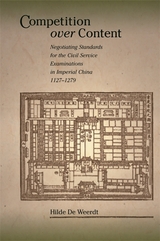 Competition over Content: Negotiating Standards for the Civil Service Examinations in Imperial China (1127–1279)
Hilde De Weerdt
Harvard University Press, 2007 Between the sixth and twentieth centuries, the civil service examinations created and maintained political coherence across the Chinese polity. Preparation for the examinations transformed the lives of literate elites by defining educational standards and disseminating a language that determined elite status. However, as participation in the examinations became central to that status, an intense competition to determine the educational curriculum and the subject matter of the examinations erupted between intellectual and political rivals. The principal goal of this book is to explain the restructuring of the examination field during a critical point in its history, the Southern Song dynasty (1127-1279), which witnessed the increasing domination of the examinations by the Neo-Confucian Learning of the Way movement.
By analyzing textbooks, examination questions and essays, and official and private commentary, Hilde De Weerdt examines how occupational, political, and intellectual groups shaped curricular standards and examination criteria and how examination standards in turn shaped political and intellectual agendas. These questions reframe the debate about the civil service examinations and their place in the imperial order.
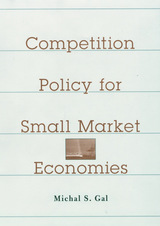 Competition Policy for Small Market Economies
Michal S. Gal
Harvard University Press, 2003 For the most part, competition policy literature has focused on large economies. Yet the economic paradigms on which such policies are based do not necessarily apply to small market economies. This book demonstrates that optimal competition policy is very much dependent on the size of an economy. Whether and how firms compete is a matter of the natural conditions of the markets in which firms operate. A critical feature of small economies is the concentrated nature of many of their markets, which are often protected by high entry barriers. Competition policy must be designed to deal effectively with these unique obstacles to competition. Accordingly, applying the same competition policy to all economies alike may be contrary to the policy's goals.
Michal Gal's thorough analysis shows the effects of market size on competition policy, ranging from rules of thumb to more general policy prescriptions, such as goals and remedial tools. Competition policy in small economies is becoming increasingly important, since the number of small jurisdictions adopting such policy is rapidly growing. Gal's focus extends beyond domestic competition policy to the evaluation of the current trend toward the worldwide harmonization of policies. This book will provide important guidance to academics, policy makers, and practitioners of competition policy as well as to anyone interested in the globalization of competition laws.
 Competitive Advantage on the Shop Floor
William Lazonick
Harvard University Press, 1990 William Lazonick explores how technological change has interacted with the organization of work, with major consequences for national competitiveness and industrial leadership. Looking at Britain, the United States, and Japan from the nineteenth century to the present, he explains changes in their status as industrial superpowers. Lazonick stresses the importance for industrial leadership of cooperative relations between employers and shop-floor workers. Such relations permit employers to use new technologies to their maximum potential, which in turn transforms the high fixed costs inherent in these technologies into low unit costs and large market shares. Cooperative relations can also lead employers to invest in the skills of workers themselves--skills that enable shop-floor workers to influence quality as well as quantity of production.
To build cooperative shop-floor relations, successful employers have been willing to pay workers higher wages than they could have secured elsewhere in the economy. They have also been willing to offer workers long-term employment security. These policies, Lazonick argues, have not come at the expense of profits but rather have been a precondition for making profits.
Focusing particularly on the role of labor-management relations in fostering "flexible mass production" in Japan since the 1950s, Lazonick criticizes those economists and politicians who, in the face of the Japanese challenge, would rely on free markets alone to restore the international competitiveness of industry in Britain and the United States.
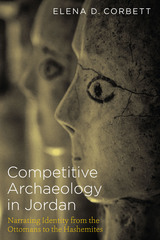 Competitive Archaeology in Jordan: Narrating Identity from the Ottomans to the Hashemites
By Elena D. Corbett
University of Texas Press, 2015 An examination of archaeology in Jordan and Palestine, Competitive Archaeology in Jordan explores how antiquities have been used to build narratives and national identities. Tracing Jordanian history, and the importance of Jerusalem within that history, Corbett analyzes how both foreign and indigenous powers have engaged in a competition over ownership of antiquities and the power to craft history and geography based on archaeological artifacts. She begins with the Ottoman and British Empires—under whose rule the institutions and borders of modern Jordan began to take shape—asking how they used antiquities in varying ways to advance their imperial projects. Corbett continues through the Mandate era and the era of independence of an expanded Hashemite Kingdom, examining how the Hashemites and other factions, both within and beyond Jordan, have tried to define national identity by drawing upon antiquities. Competitive Archaeology in Jordan traces a complex history through the lens of archaeology’s power as a modern science to create and give value to spaces, artifacts, peoples, narratives, and academic disciplines. It thus considers the role of archaeology in realizing Jordan’s modernity—drawing its map; delineating sacred and secular spaces; validating taxonomies of citizens; justifying legal frameworks and institutions of state; determining logos of the nation for display on stamps, currency, and in museums; and writing history. Framing Jordan’s history in this way, Corbett illustrates the manipulation of archaeology by governments, institutions, and individuals to craft narratives, draw borders, and create national identities.
The Competitive City: The Political Economy of Suburbia
Mark Schneider
University of Pittsburgh Press, 1991 This timely and important book, which won a special citation from the American Political Science Association’s Urban Affairs Section for its “major theoretical development,” analyzes the effect of competition among suburban communities to attract residents and business with the best public services and the lowest taxes. Using data from a large sample of suburban cities, Mark Schneider offers a theoretical extension of the Tiebout-Peterson approach to understanding public policies and integrates this perspective with recent work on the power of bureaucrats to control budgets.
Competitive Elections in Developing Countires
Myron Weiner and Ergun Özbudun
Duke University Press, 1987 This is the latest in the At the Polls series, in which Duke University Press has joined with the American Enterprise Institute for Public Policy Research to publish studies on the electoral process as it functions around the world. Cited by Choice for its "high standard of scholarly analysis and objectivity," the series provides both a chronicle of events and a thorough analysis of the election results.
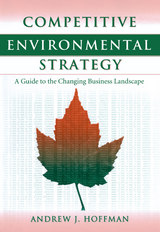 Competitive Environmental Strategy: A Guide To The Changing Business Landscape
Andrew J. Hoffman
Island Press, 2000 Environmental concerns can greatly affect business success, regardless of whether a business person or corporation shares those concerns. Today's corporate managers must understand the power of environmental issues, and shift their mindset from one focused on environmental "management" to one focused on strategy.Competitive Environmental Strategy examines the effects of environmentalism on corporate management, explaining how and why environmental forces are driving change and how business managers can think about environmental issues in a strategic way. The author discusses: the evolving drivers of corporate environmental strategy, including regulators, shareholders, buyers and suppliers, insurers, investors, and consumers how environmentalism alters basic conceptions of competitive strategy and organizational design how external institutions create both opportunity and limitations for environmental strategy how environmental threats can be incorporated into risk management, capital acquisition, competitive position, and other management concerns The book ends with an overall discussion of competitive environmental strategy and draws connections to the emerging issue of sustainable development. Each chapter features insets that ask fundamental questions about the relationship between environmental protection and business strategy, and ends with a list of additional recommended readings. Every individual who wishes to engage in business management in the 21st century will need an appreciation for the implications of environmental issues on corporate activities, and vice-versa.Competitive Environmental Strategy offers a valuable overview of the subject, and provides a wealth of real-world examples that demonstrate the validity and applicability of the concepts for business people, clearly showing how managers are turning an understanding of environmental issues to competitive advantage.
 The Competitive Ethos and Democratic Education
John G. Nicholls
Harvard University Press, 1989 Young children and even infants work hard at mastering various kills and show spontaneous pleasure at their own accomplishment. John Nicholls explores the conditions that cause students to lose their unselfconscious involvement in a game or task and become concerned with how they are stacking up against others. Charting the development of children’s concepts of luck, effort, and ability, he argues that with age they are increasingly prone to take superiority over others as the definition of success. An emphasis on interpersonal competition, which permeates Western society, exacerbates this egotistical tendency and results in diminished accomplishment and alienation from school.
To overcome these problems, Nicholls argues, we must “become as little children” for whom absorption in exploration and accomplishment come naturally, even when those around them are more competent. This ideal is unlikely to be promoted through technical approaches to education, or by the current emphasis on the role of education in economic development. Instead, Nicholls calls for a progressive approach to education. Difficult though it is to implement, this approach is most likely to increase equality of motivation for intellectual development, substantial accomplishment, satisfaction in work, and more productive relations with others. These are important ideas for anyone interested in achievement motivation, for those professionally involved in education, and for nonspecialists interested in, or worried about, how we educate our children.
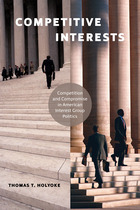 Competitive Interests: Competition and Compromise in American Interest Group Politics
Thomas T. Holyoke
Georgetown University Press, 2011 Competitive Interests does more than simply challenge the long-held belief that a small set of interests control large domains of the public policy making landscape. It shows how the explosion in the sheer number of new groups, and the broad range of ideological demands they advocate, have created a form of group politics emphasizing compromise as much as conflict. Thomas T. Holyoke offers a model of strategic lobbying that shows why some group lobbyists feel compelled to fight stronger, wealthier groups even when they know they will lose. Holyoke interviewed 83 lobbyists who have been advocates on several contentious issues, including Arctic oil drilling, environmental conservation, regulating genetically modified foods, money laundering, and bankruptcy reform. He offers answers about what kinds of policies are more likely to lead to intense competition and what kinds of interest groups have an advantage in protracted conflicts. He also discusses the negative consequences of group competition, such as legislative gridlock, and discusses what lawmakers can do to steer interest groups toward compromise. The book concludes with an exploration of greater group competition, conflict, and compromise and what consequences this could have for policymaking in a representation-based political system.
Competitive Interference and Twentieth Century Diplomacy
Richard W. Cottam
University of Pittsburgh Press, 1967
With nuclear proliferation essentially eliminating full-scale warfare, governments have increasingly turned to what Richard W. Cottam calls competitive interference. This type of policy invokes counter-insurgency, political, economic, and psychological manipulations, and often involves looking deeply into the internal affairs of a country, often secretly. Cottam describes and defines competitive interference, explores the United States' institutional adjustment to it, and provides a theoretical framework for projection and evaluation of foreign policy in this changing diplomatic arena. He uses case studies of international relationships involving the United States, India, China, Vietnam, Iran, and the former USSR and East Germany to evaluate his theoretical stance, and proposes long-term institutionalization of policy, rather than covert operations.
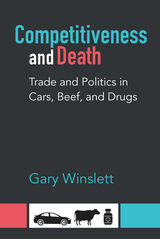 Competitiveness and Death: Trade and Politics in Cars, Beef, and Drugs
Gary Winslett
University of Michigan Press, 2021 Competitiveness and Death examines the increase and reduction of regulatory barriers to trade across three industries: environmental, labor, and safety rules on automobiles, consumer protection regulations on meat, and intellectual property regulations on medicines. The fundamental negotiation in trade and regulatory policymaking occurs between businesses, activists, and government officials.
Gary Winslett builds on new trade theories to explain when and why businesses are most likely to lobby governments to reduce these regulatory trade barriers. He argues that businesses prevail when they can connect with broader concerns about national economic competitiveness. He examines how activist organizations overcome collective action problems and defend regulatory differences, arguing that they succeed when they can link their desire for barriers with preventing needless death. Competitiveness and Death provides a political companion to new trade theories in economics, questioning cleavage-based explanations of trade politics, demonstrating the underappreciated importance of activists, suggesting the limits of globalization, providing in-depth examination of previously ignored trade negotiations, qualifying the California Effect (the shift toward stricter regulatory standards), and showing the relative rarity of regulations used as disguised protectionism.
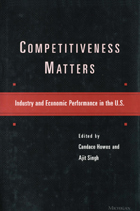 Competitiveness Matters: Industry and Economic Performance in the U.S.
Candace Howes and Ajit Singh, Editors
University of Michigan Press, 2000 This book argues, against the current view, that competitiveness--that is, the competitiveness of the manufacturing sector--matters to the long-term health of the U.S. economy and particularly to its long-term capacity to raise the standard of living of its citizens. The book challenges the arguments popularized most recently by Paul Krugman that
competitiveness is a dangerous obsession that distracts us from the question most central to solving the problem of stagnant real income growth, namely, what causes productivity growth, especially in the service sector.
The central argument is that, if the U.S. economy is to achieve full employment with rising real wages, it is necessary to enhance the competitiveness of its tradable goods sector. The book shows that current account deficits cannot be explained by macroeconomic mismanagement but are rather the consequence of an uncompetitive manufacturing sector. It finds that the long-term health of the manufacturing sector requires not only across-the-board policies to remedy problems of low or inefficient investment, but also sectoral policies to address problems that are strategic to resolving the balance of payments problems. Lessons are drawn from the experience of some European and Asian countries.
This book will be of interest to economists, political scientists, and business researchers concerned with the place of the manufacturing sector in overall health of the U.S. economy, with issues of industrial policy and industrial restructuring, and with the conditions for rising standards of living.
Candace Howes is Associate Professor, Barbara Hogate Ferrin Chair, Connecticut College. Ajit Singh is Professor of Economics, Queens College, Cambridge.
Complacency and Collusion: A Critical Introduction to Business and Financial Journalism
Keith J. Butterick
Pluto Press, 2015 In Complacency and Collusion, Keith J. Butterick draws on extensive experience as a journalist and scholar to show why financial and business journalism is so often toothless. He offers compelling explanations for why big business needs the press—and vice versa—and presents piercing analyses of the inadequacies of reporting in such major outlets as the Economist and the Financial Times, showing how those failures are rooted in the close relationship between businesses and those covering them. He concludes with a reflection on what the growth and spread of a complacent, complicit corporate journalism will mean for the future of a truly free media.
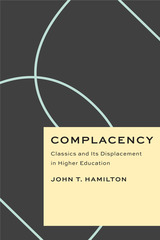 Complacency: Classics and Its Displacement in Higher Education
John T. Hamilton
University of Chicago Press, 2022 A critical reflection on complacency and its role in the decline of classics in the academy.
In response to philosopher Simon Blackburn’s portrayal of complacency as a vice that impairs university study at its core, John T. Hamilton examines the history of complacency in classics and its implications for our contemporary moment.
The subjects, philosophies, and literatures of ancient Greece and Rome were once treated as the foundation of learning, with everything else devolving from them. Hamilton investigates what this model of superiority, derived from the golden age of the classical tradition, shares with the current hegemony of mathematics and the natural sciences. He considers how the qualitative methods of classics relate to the quantitative positivism of big data, statistical reasoning, and presumably neutral abstraction, which often dismiss humanist subjectivity, legitimize self-sufficiency, and promote a fresh brand of academic complacency. In acknowledging the reduced status of classics in higher education today, he questions how scholarly striation and stagnation continue to bolster personal, ethical, and political complacency in our present era.
 Complaint!
Sara Ahmed
Duke University Press, 2021 In Complaint! Sara Ahmed examines what we can learn about power from those who complain about abuses of power. Drawing on oral and written testimonies from academics and students who have made complaints about harassment, bullying, and unequal working conditions at universities, Ahmed explores the gap between what is supposed to happen when complaints are made and what actually happens. To make complaints within institutions is to learn how they work and for whom they work: complaint as feminist pedagogy. Ahmed explores how complaints are made behind closed doors and how doors are often closed on those who complain. To open these doors---to get complaints through, keep them going, or keep them alive---Ahmed emphasizes, requires forming new kinds of collectives. This book offers a systematic analysis of the methods used to stop complaints and a powerful and poetic meditation on what complaints can be used to do. Following a long lineage of Black feminist and feminist of color critiques of the university, Ahmed delivers a timely consideration of how institutional change becomes possible and why it is necessary.
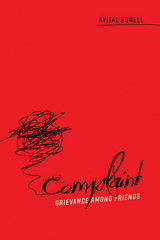 Complaint: Grievance among Friends
Avital Ronell
University of Illinois Press, 2018 “It is not, nor it cannot come to good. But break, my heart, for I must hold my tongue.” Thus spoke Hamlet, one of the great kvetchers of literature. Every day, gripers challenge our patience and compassion. Yet Pollyannas rile us up with their grotesque contentment and unfathomable rejection of protest. Avital Ronell considers how literature and philosophy treat bellyachers, wailers, and grumps—and the complaints they lavish on the rest of us. Combining her trademark jazzy panache with a fearless range of readings, Ronell opens a dialogue with readers that discusses thinkers with whom she has directly engaged. Beginning with Hamlet, and with a candid awareness of her own experiences, Ronell proceeds to show how complaining is aggravated, distracted, stifled, and transformed. She moves on to the exemplary complaints of Friedrich Nietzsche, Hannah Arendt, and Barbara Johnson and examines the complaint-riven history of deconstruction. Infused with the author’s trademark wit, Complaint takes friends, colleagues, and all of us on a courageous philosophical journey.
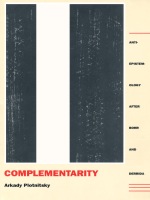 Complementarity: Anti-Epistemology after Bohr and Derrida
Arkady Plotnitsky
Duke University Press, 1994 Many commentators have remarked in passing on the resonance between deconstructionist theory and certain ideas of quantum physics. In this book, Arkady Plotnitsky rigorously elaborates the similarities and differences between the two by focusing on the work of Niels Bohr and Jacques Derrida. In detailed considerations of Bohr’s notion of complementarity and his debates with Einstein, and in analysis of Derrida’s work via Georges Bataille’s concept of general economy, Plotnitsky demonstrates the value of exploring these theories in relation to each other.
Bohr’s term complementarity describes a situation, unavoidable in quantum physics, in which two theories thought to be mutually exclusive are required to explain a single phenomenon. Light, for example, can only be explained as both wave and particle, but no synthesis of the two is possible. This theoretical transformation is then examined in relation to the ways that Derrida sets his work against or outside of Hegel, also resisting a similar kind of synthesis and enacting a transformation of its own.
Though concerned primarily with Bohr and Derrida, Plotnitsky also considers a wide range of anti-epistemological endeavors including the work of Nietzsche, Bataille, and the mathematician Kurt Gödel. Under the rubric of complementarity he develops a theoretical framework that raises new possiblilities for students and scholars of literary theory, philosophy, and philosophy of science.
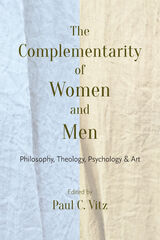 The Complementarity of Women and Men: Philosophy, Theology, Psychology, and Art
Paul C. Vitz
Catholic University of America Press, 2021 The Complementarity of Women and Men provides a Catholic Christian case that men and women are in certain respects quite different but also have a positive, synergistic complementary relationship. Although differences and their mutually supporting relationships are focused on throughout the volume, men and women are assumed to have equal dignity and value. This underlying interpretation comes from the familiar, basic theological position in Genesis that both sexes were made in the image of God.
After a cogent philosophical introduction to complementary differences by J. Budziszewski, this position is developed from theological, philosophical, and historical perspectives by Sr. Prudence Allen. Next Deborah Savage, building upon the writings of St. John Paul II, gives a strong theological basis for complementarity. This is followed by Elizabeth Lev’s chapter presenting new and surprising art history evidence from the paintings of Michelangelo in the Sistine Chapel supporting the complementarity interpretation. A final chapter by Paul Vitz documents and summarizes the scientific evidence supporting sexual difference and complementarity in the disciplines of psychology and neuroscience.
As a consequence of both the individual chapters and the integrated understanding they present The Complementarity of Women and Men is a significant contribution to the important, complex, contemporary debate about men, women, sex, and gender.
The Complete Anti-Federalist
Edited by Herbert J. Storing
University of Chicago Press, 2007 The Complete Anti-Federalist, first published in 1981, contains an unprecedented collection of all the significant pamphlets, newspaper articles and letters, essays, and speeches that were written in opposition to the Constitution during the ratification debate. Storing’s work includes introductions to each entry, along with his own consideration of the Anti-Federalist thought.
This new three-volume set includes all the contents of the original seven-volume publication in a convenient, manageable format.
“A work of magnificent scholarship. Publication of these volumes is a civic event of enduring importance.”—Leonard W. Levy, New York Times Book Review
 The Complete Cardinal Guide to Planning for and Living in Retirement
Hans "John" Scheil
Tupelo Press, 2016 The financial complexities we face in retirement can be daunting. The landscape of Social Security, Medicare, insurance, benefits, investments, and planning for long-term care presents many choices, challenges, and opportunities. The Complete Cardinal Guide gives you the tools you need to understand how to make informed decisions that are right for you. The purpose of this book is to guide you through the major retirement options that retirees face. It explains simple and effective strategies you can put in place now, with the help of professionals, to make your retirement financially successful. Author and founder of Cardinal Retirement Planning Hans “John” Scheil, a Certified Financial Planner™ (CFP®) and Chartered Advisor for Senior Living (CASL®), calls upon his 40 years of experience in the business to answer the following questions in depth, and he illustrates each with real-life stories: At what age should I start receiving my Social Security check?, What’s the best way to supplement my Medicare coverage?, Can I receive long-term care and stay at home? How do I afford it? ,How should I handle my IRA and/or 401k accounts?, What’s a smart investment strategy for financing my retirement years?, How do my income taxes change after I retire?, What if I live longer than my retirement savings last?, What’s the best way to transfer my life insurance and other assets to my children and grandchildren?, How do I ensure my survivors are OK after I die?,How should I approach choosing financial and legal professionals to help me plan my retirement?
The Complete Cardinal Guide to Planning for and Living in Retirement Workbook
Hans "John" Scheil
Tupelo Press, 2017 In 2016, Leapfolio published the Complete Cardinal Guide to Planning for and Living in Retirement. The Guide provides an overview of the major problems that retirees face and the simple strategies they can implement to make their retirement financially successful. The Guide fulfilled Cardinal’s expectations and proved to be a success, as they sold or distributed more than 6,000 copies in the past year. But they also learned that the Guide isn’t quite sufficient by itself. So they’ve created this Workbook to offer additional examples of real-life situations, products, and strategies, and guidance to help people prepare to discuss retirement planning with a professional advisor.
 The Complete Civil War Journal and Selected Letters of Thomas Wentworth Higginson
Thomas Wentworth Higginson
University of Chicago Press, 1999 "I desire to record, as simply as I may, the beginnings of a momentous military experiment, whose ultimate results were the reorganization of the whole American army and the remoulding of the relations of two races on this continent. . . . I can only hope that the importance of the subject may save me from that egotism which makes great things seem little and little things seem less in the narrating."
So wrote Thomas Wentworth Higginson about his role in one of the most compelling and fascinating episodes in the history of the United States. As the colonel of the first regiment of black men in the Union army during the Civil War, Higginson was an early, articulate, and powerful crusader for civil rights, and his journal and letters, collected for the first time in this volume, present some of the most extraordinary documents of the Civil War.
Higginson was a politically engaged intellectual at the forefront of radical antislavery, labor, and feminist causes. Born in 1823 to a formerly wealthy but still prominent Brahmin family, he became one of America's leading social activists and a prominent writer, minister, and reformer. With the publication in 1869 of his classic Army Life in a Black Regiment, which drew on this journal, Higginson became one of the most important chroniclers of the Civil War. The Complete Civil War Journal and Selected Letters of Thomas Wentworth Higginson is the first comprehensive edition of his journal. Sensitively and thoroughly annotated by Christopher Looby and supplemented by a large selection of Higginson's wartime letters, this volume offers the most vivid and intimate picture of the radical interracial solidarity brought about by the transformative experience of the army camp and of Civil War life.
"The immediacy of Higginson's reflections, as well as their sharp insights, make this journal both distinctive and enduringly compelling . . . . Higginson's vivid texts can once again educate, gratify and delight readers."—Publishers Weekly
"This volume will enrich our understanding of the transformations that emancipation and war wrought."—Library Journal
 The Complete Collections Assessment Manual: A Holistic Approach
Madeline M. Kelly
American Library Association, 2020 Assessment is increasingly integral to building, managing, and justifying library collections. Unfortunately, assessment can also be a daunting undertaking. And though every institution is unique, as this manual demonstrates, there’s no need to reinvent the wheel. Spanning both concept and practice, Kelly offers a holistic assessment framework suitable to a variety of collections and contexts. With a structure that makes it applicable as both a training tool for practicing librarians and a useful course text for library students, this manual - introduces foundational assessment methodologies then provides concrete guidance on how to contextualize those methodologies within a holistic collections assessment program;
- covers topics such as assessment goals, assessment stakeholders, selecting data and methodologies, working through project constraints, and project planning;
- includes sample assessment program structures and other useful templates;
- provides step-by-step instructions for more than a dozen specific methodologies, describing which aspect of the collection is being measured, what goals the methodology can address, technological requirements, recommended visualizations, and other helpful pointers; and
- shares best practices for communicating effectively with internal and external stakeholders about assessment projects, with sample communication plans that can be easily adapted.
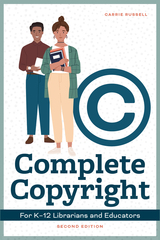 Complete Copyright for K12 Librarians and Educators
Carrie Russell
American Library Association, 2023 Particularly in places of learning, technology is all-pervasive; because everyone is always making copies, copyright is center stage. And copyright law, when misapplied or misinterpreted, affects not only the way that you teach but even what you teach. With decades of experience interpreting the intricacies of copyright law as it pertains to librarianship, Russell is the ideal authority to address the concerns of librarians, teachers, and teaching librarians who work in the K–12 environment. Her book will encourage you to stop allowing your fear of copyright issues to limit how and what you share or teach, and instead be more involved in shaping copyright law to better serve your learning community. Through scenario-based discussions, it covers key topics such as - the reasons librarians and teachers have so many misconceptions about copyright, and why understanding copyright is a process, not a one-time event;
- recent legislative and policy developments that impact schools and libraries;
- situations often encountered by educators, such as using copyrighted material in class assignments, digital lesson plans, bulletin board displays, social media, school plays, and band performances and talent shows;
- the use of licensed content in a variety of settings;
- what constitutes "fair use," so that you can be empowered by knowing exactly what's possible within the law; and
- guidance on making long-term strategic decisions and developing copyright policies.
 The Complete Correspondence, 1928–1940
Theodor W. Adorno and Walter Benjamin
Harvard University Press, 1999 The correspondence between Walter Benjamin and Theodor Adorno, which appears here for the first time in its entirety in English translation, must rank among the most significant to have come down to us from that notable age of barbarism, the twentieth century. Benjamin and Adorno formed a uniquely powerful pair. Benjamin, riddle-like in his personality and given to tactical evasion, and Adorno, full of his own importance, alternately support and compete with each other throughout the correspondence, until its imminent tragic end becomes apparent to both writers. Each had met his match, and happily, in the other. This book is the story of an elective affinity. Adorno was the only person who managed to sustain an intimate intellectual relationship with Benjamin for nearly twenty years. No one else, not even Gershom Scholem, coaxed so much out of Benjamin.
The more than one hundred letters in this book will allow readers to trace the developing character of Benjamin's and Adorno's attitudes toward each other and toward their many friends. When this book appeared in German, it caused a sensation because it includes passages previously excised from other German editions of the letters--passages in which the two friends celebrate their own intimacy with frank remarks about other people. Ideas presented elliptically in the theoretical writings are set forth here with much greater clarity. Not least, the letters provide material crucial for understanding the genesis of Benjamin's Arcades Project.
The Complete Correspondence of Sigmund Freud and Ernest Jones, 1908–1939
Sigmund Freud and Ernest Jones
Harvard University Press, 1993 Soon after their first meeting in 1908, Sigmund Freud’s future biographer, Ernest Jones, initiated a correspondence with the founder of psychoanalysis that would continue until Freud’s death in London in 1939. This volume makes available from British and American archives nearly seven hundred previously unpublished letters, postcards, and telegrams from the three-decade correspondence between Freud and his admiring younger colleague.
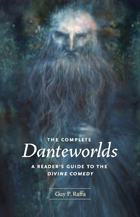 The Complete Danteworlds: A Reader's Guide to the Divine Comedy
Guy P. Raffa
University of Chicago Press, 2009 Dante Alighieri’s Divine Comedy has, despite its enormous popularity and importance, often stymied readers with its multitudinous characters, references, and themes. But until the publication in 2007 of Guy Raffa’s guide to the Inferno, students lacked a suitable resource to help them navigate Dante’s underworld. With this new guide to the entire Divine Comedy, Raffa provides readers—experts in the Middle Ages and Renaissance, Dante neophytes, and everyone in between—with a map of the entire poem, from the lowest circle of Hell to the highest sphere of Paradise. Based on Raffa’s original research and his many years of teaching the poem to undergraduates, The CompleteDanteworlds charts a simultaneously geographical and textual journey, canto by canto, region by region, adhering closely to the path taken by Dante himself through Hell, Purgatory, and Paradise. This invaluable reference also features study questions, illustrations of the realms, and regional summaries. Interpreting Dante’s poem and his sources, Raffa fashions detailed entries on each character encountered as well as on many significant historical, religious, and cultural allusions.
 The Complete Ezra Taft Benson FBI File
Signature Books
Signature Books, 2020 In November 1952, newly elected US president Dwight D. Eisenhower nominated Ezra Taft Benson (1899–1994) as his Secretary of Agriculture. This was an unusual move. For nearly a decade, Benson had been a sitting apostle in the Church of Jesus Christ of Latter-day Saints and had been for nearly a decade. Benson’s church duties occupied his full attention and energy.
Shortly after Benson’s nomination as agricultural secretary, the FBI began keeping a routine file on him, as they did other prominent Americans slated for Eisenhower’s cabinet. Filled with letters, memoranda, newspaper clippings, speeches, published writings, and other items, the file spans Benson’s eight-year tenure with the administration and well beyond. Some of the documents date past the Eisenhower era and even into Benson’s years as president of the LDS Church (1985–94). The material not only deals with Benson’s life and political views, but his association with the John Birch Society, its leaders, and even threats made against his life in the late 1980s. The 570-page dossier is as much a revelation about the workings of the FBI as about the man they were investigating.
The Complete Fables of Jean de La Fontaine
Jean de La Fontaine
University of Illinois Press, 2007 Inspired new translations of the work of one of the world's greatest fabulists Told in an elegant style, Jean de la Fontaine's (1621-95) charming animal fables depict sly foxes and scheming cats, vain birds and greedy wolves, all of which subtly express his penetrating insights into French society and the beasts found in all of us. Norman R. Shapiro has been translating La Fontaine's fables for over twenty years, capturing the original work's lively mix of plain and archaic language. This newly complete translation is destined to set the English standard for this work.
Awarded the Lewis Galantière Prize by the American Translators Association, 2008.
The Complete Fables of Jean de la Fontaine
Jean de la Fontaine, edited and with a rhymed verse translation by Norman B. Spector
Northwestern University Press, 1988 This edition of The Complete Fables of Jean de la Fontaine includes an English translation published alongside the French text. Norman Spector adapted the French text from the 1883–85 edition by Henri Régnier, adding four tales from the 1962 edition by Georges Couton. Spector’s translation is in rhymed verse, and remains faithful to the original not only in metrical patterns and rhyme schemes but also in tone: wit and le mot juste are skillfully and wonderfully combined. This translation gives the reader of English a chance to enjoy the grace, wit, and versatility of La Fontaine.
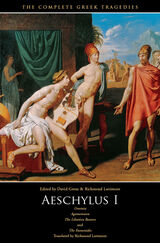 The Complete Greek Tragedies: Aeschylus I
Edited by David Grene and Richmond Lattimore
University of Chicago Press, 1969 "These authoritative translations consign all other complete collections to the wastebasket."—Robert Brustein, The New Republic
"This is it. No qualifications. Go out and buy it everybody."—Kenneth Rexroth, The Nation
"The translations deliberately avoid the highly wrought and affectedly poetic; their idiom is contemporary....They have life and speed and suppleness of phrase."—Times Education Supplement
"These translations belong to our time. A keen poetic sensibility repeatedly quickens them; and without this inner fire the most academically flawless rendering is dead."—Warren D. Anderson, American Oxonian
"The critical commentaries and the versions themselves...are fresh, unpretentious, above all, functional."—Commonweal
"Grene is one of the great translators."—Conor Cruise O'Brien, London Sunday Times
"Richmond Lattimore is that rara avis in our age, the classical scholar who is at the same time an accomplished poet."—Dudley Fitts, New York Times Book Review
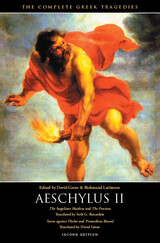 The Complete Greek Tragedies: Aeschylus II
Edited by David Grene and Richmond Lattimore
University of Chicago Press, 1991 The Grene and Lattimore edition of the Greek tragedies has been among the most widely acclaimed and successful publications of the University of Chicago Press. On the occasion of the Centennial of the University of Chicago and its Press, we take pleasure in reissuing this complete work in a handsome four-volume slipcased edition as well as in redesigned versions of the familiar paperbacks.
For the Centennial Edition two of the original translations have been replaced. In the original publication David Grene translated only one of the three Theban plays, Oedipus the King. Now he has added his own translations of the remaining two, Oedipus at Colonus and Antigone, thus bringing a new unity of tone and style to this group. Grene has also revised his earlier translation of Prometheus Bound and rendered some of the former prose sections in verse. These new translations replace the originals included in the paperback volumes Sophocles I (which contains all three Theban plays), Aeschylus II, Greek Tragedies, Volume I, and Greek Tragedies, Volume III, all of which are now being published in second editions.
All other volumes contain the translations of the tragedies of Aeschylus, Sophocles, and Euripides for the most part from the original versions first published in the 1940s and 1950s. These translations have been the choice of generations of teachers and students, selling in the past forty years over three million copies.
The Complete Greek Tragedies: Euripides I
Edited by David Grene and Richmond Lattimore
University of Chicago Press, 1955 In nine paperback volumes, the Grene and Lattimore editions offer the most comprehensive selection of the Greek tragedies available in English. Over the years these authoritative, critically acclaimed editions have been the preferred choice of over three million readers for personal libraries and individual study as well as for classroom use.
The Complete Greek Tragedies: Euripides II
Edited by David Grene and Richmond Lattimore
University of Chicago Press, 1956 In nine paperback volumes, the Grene and Lattimore editions offer the most comprehensive selection of the Greek tragedies available in English. Over the years these authoritative, critically acclaimed editions have been the preferred choice of over three million readers for personal libraries and individual study as well as for classroom use.
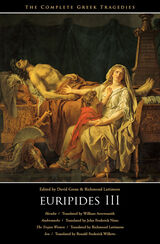 The Complete Greek Tragedies: Euripides III
Edited by David Grene and Richmond Lattimore
University of Chicago Press, 1992 In nine paperback volumes, the Grene and Lattimore editions offer the most comprehensive selection of the Greek tragedies available in English. Over the years these authoritative, critically acclaimed editions have been the preferred choice of over three million readers for personal libraries and individual study as well as for classroom use.
"These authoritative translations consign all other complete collections to the wastebasket."—Robert Brustein, The New Republic
"This is it. No qualifications. Go out and buy it everybody."—Kenneth Rexroth, The Nation
"The translations deliberately avoid the highly wrought and affectedly poetic; their idiom is contemporary....They have life and speed and suppleness of phrase."—Times Education Supplement
"These translations belong to our time. A keen poetic sensibility repeatedly quickens them; and without this inner fire the most academically flawless rendering is dead."—Warren D. Anderson, American Oxonian
"The critical commentaries and the versions themselves...are fresh, unpretentious, above all, functional."—Commonweal
"Grene is one of the great translators."—Conor Cruise O'Brien, London Sunday Times
"Richmond Lattimore is that rara avis in our age, the classical scholar who is at the same time an accomplished poet."—Dudley Fitts, New York Times Book Review
The Complete Greek Tragedies: Euripides IV
Edited by David Grene and Richmond Lattimore
University of Chicago Press, 1968 In nine paperback volumes, the Grene and Lattimore editions offer the most comprehensive selection of the Greek tragedies available in English. Over the years these authoritative, critically acclaimed editions have been the preferred choice of over three million readers for personal libraries and individual study as well as for classroom use.
The Complete Greek Tragedies: Euripides V
Edited by David Grene and Richmond Lattimore
University of Chicago Press, 1969 In nine paperback volumes, the Grene and Lattimore editions offer the most comprehensive selection of the Greek tragedies available in English. Over the years these authoritative, critically acclaimed editions have been the preferred choice of over three million readers for personal libraries and individual study as well as for classroom use.
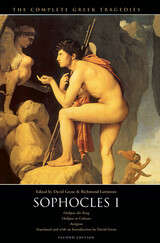 The Complete Greek Tragedies: Sophocles I
Edited by David Grene
University of Chicago Press, 1991 "These authoritative translations consign all other complete collections to the wastebasket."—Robert Brustein, The New Republic
"This is it. No qualifications. Go out and buy it everybody."—Kenneth Rexroth, The Nation
"The translations deliberately avoid the highly wrought and affectedly poetic; their idiom is contemporary....They have life and speed and suppleness of phrase."—Times Education Supplement
"These translations belong to our time. A keen poetic sensibility repeatedly quickens them; and without this inner fire the most academically flawless rendering is dead."—Warren D. Anderson, American Oxonian
"The critical commentaries and the versions themselves...are fresh, unpretentious, above all, functional."—Commonweal
"Grene is one of the great translators."—Conor Cruise O'Brien, London Sunday Times
"Richmond Lattimore is that rara avis in our age, the classical scholar who is at the same time an accomplished poet."—Dudley Fitts, New York Times Book Review
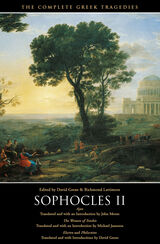 The Complete Greek Tragedies: Sophocles II
Edited by David Grene and Richmond Lattimore
University of Chicago Press, 1969 "These authoritative translations consign all other complete collections to the wastebasket."—Robert Brustein, The New Republic
"This is it. No qualifications. Go out and buy it everybody."—Kenneth Rexroth, The Nation
"The translations deliberately avoid the highly wrought and affectedly poetic; their idiom is contemporary....They have life and speed and suppleness of phrase."—Times Education Supplement
"These translations belong to our time. A keen poetic sensibility repeatedly quickens them; and without this inner fire the most academically flawless rendering is dead."—Warren D. Anderson, American Oxonian
"The critical commentaries and the versions themselves...are fresh, unpretentious, above all, functional."—Commonweal
"Grene is one of the great translators."—Conor Cruise O'Brien, London Sunday Times
"Richmond Lattimore is that rara avis in our age, the classical scholar who is at the same time an accomplished poet."—Dudley Fitts, New York Times Book Review
 The Complete Greek Tragedies, Volume 1: Aeschylus
Edited by David Grene and Richmond Lattimore
University of Chicago Press, 1992 The Grene and Lattimore edition of the Greek tragedies has been among the most widely acclaimed and successful publications of the University of Chicago Press. On the occasion of the Centennial of the University of Chicago and its Press, we take pleasure in reissuing this complete work in a handsome four-volume slipcased edition as well as in redesigned versions of the familiar paperbacks.
For the Centennial Edition two of the original translations have been replaced. In the original publication David Grene translated only one of the three Theban plays, Oedipus the King. Now he has added his own translations of the remaining two, Oedipus at Colonus and Antigone, thus bringing a new unity of tone and style to this group. Grene has also revised his earlier translation of Prometheus Bound and rendered some of the former prose sections in verse. These new translations replace the originals included in the paperback volumes Sophocles I (which contains all three Theban plays), Aeschylus II, Greek Tragedies, Volume I, and Greek Tragedies, Volume III, all of which are now being published in second editions.
All other volumes contain the translations of the tragedies of Aeschylus, Sophocles, and Euripides for the most part from the original versions first published in the 1940s and 1950s. These translations have been the choice of generations of teachers and students, selling in the past forty years over three million copies.
 The Complete Greek Tragedies, Volume 2: Sophocles
Edited by David Grene and Richmond Lattimore
University of Chicago Press, 1992 The Grene and Lattimore edition of the Greek tragedies has been among the most widely acclaimed and successful publications of the University of Chicago Press. On the occasion of the Centennial of the University of Chicago and its Press, we take pleasure in reissuing this complete work in a handsome four-volume slipcased edition as well as in redesigned versions of the familiar paperbacks.
For the Centennial Edition two of the original translations have been replaced. In the original publication David Grene translated only one of the three Theban plays, Oedipus the King. Now he has added his own translations of the remaining two, Oedipus at Colonus and Antigone, thus bringing a new unity of tone and style to this group. Grene has also revised his earlier translation of Prometheus Bound and rendered some of the former prose sections in verse. These new translations replace the originals included in the paperback volumes Sophocles I (which contains all three Theban plays), Aeschylus II, Greek Tragedies, Volume I, and Greek Tragedies, Volume III, all of which are now being published in second editions.
All other volumes contain the translations of the tragedies of Aeschylus, Sophocles, and Euripides for the most part from the original versions first published in the 1940s and 1950s. These translations have been the choice of generations of teachers and students, selling in the past forty years over three million copies.
 The Complete Greek Tragedies, Volume 3: Euripides
Edited by David Grene and Richmond Lattimore
University of Chicago Press, 1992 The Grene and Lattimore edition of the Greek tragedies has been among the most widely acclaimed and successful publications of the University of Chicago Press. On the occasion of the Centennial of the University of Chicago and its Press, we take pleasure in reissuing this complete work in a handsome four-volume slipcased edition as well as in redesigned versions of the familiar paperbacks.
For the Centennial Edition two of the original translations have been replaced. In the original publication David Grene translated only one of the three Theban plays, Oedipus the King. Now he has added his own translations of the remaining two, Oedipus at Colonus and Antigone, thus bringing a new unity of tone and style to this group. Grene has also revised his earlier translation of Prometheus Bound and rendered some of the former prose sections in verse. These new translations replace the originals included in the paperback volumes Sophocles I (which contains all three Theban plays), Aeschylus II, Greek Tragedies, Volume I, and Greek Tragedies, Volume III, all of which are now being published in second editions.
All other volumes contain the translations of the tragedies of Aeschylus, Sophocles, and Euripides for the most part from the original versions first published in the 1940s and 1950s. These translations have been the choice of generations of teachers and students, selling in the past forty years over three million copies.
 The Complete Greek Tragedies, Volume 4: Euripides
Edited by David Grene and Richmond Lattimore
University of Chicago Press, 1992 The Grene and Lattimore edition of the Greek tragedies has been among the most widely acclaimed and successful publications of the University of Chicago Press. On the occasion of the Centennial of the University of Chicago and its Press, we take pleasure in reissuing this complete work in a handsome four-volume slipcased edition as well as in redesigned versions of the familiar paperbacks.
For the Centennial Edition two of the original translations have been replaced. In the original publication David Grene translated only one of the three Theban plays, Oedipus the King. Now he has added his own translations of the remaining two, Oedipus at Colonus and Antigone, thus bringing a new unity of tone and style to this group. Grene has also revised his earlier translation of Prometheus Bound and rendered some of the former prose sections in verse. These new translations replace the originals included in the paperback volumes Sophocles I (which contains all three Theban plays), Aeschylus II, Greek Tragedies, Volume I, and Greek Tragedies, Volume III, all of which are now being published in second editions.
All other volumes contain the translations of the tragedies of Aeschylus, Sophocles, and Euripides for the most part from the original versions first published in the 1940s and 1950s. These translations have been the choice of generations of teachers and students, selling in the past forty years over three million copies.
 The Complete Guide to Environmental Careers in the 21st Century
Environmental Careers Organization
Island Press, 1999 Compiled by the acknowledged leaders in environmental career information, The Complete Guide to Environmental Careers in the 21st Century is a completely revised and updated edition of what has become the standard reference on the subject. Organized for ease of use and fully updated to reflect ongoing changes in environmental fields, it is the most comprehensive and reliable resource available for anyone seeking information about environmental career opportunities and how to get started in one. The book presents: a thorough consideration of environmental trends for the 21st century and the likely impact of those trends on future career opportunities an overview of environmental professions including a statistical review of the private sector environmental industry, state and local government, federal government, academia, and nonprofits valuable tips on career search strategies along with information about education, volunteering, and internships case studies of representative work and individual profiles that give readers an up-close and personal look at a variety of environmental professionals, what they really do, and how they arrived at their current positions resources for further information including more than 100 of the top web sites for the environmental career seeke. Chapters examine the entire spectrum of career fields, with each chapter providing an "at a glance" summary of the field; discussion of history and background along with current issues and trends; examination of specific career opportunities and the educational requirements for each; salary ranges by type of employer, level of experience, and responsibility; and an extensive list of resources for further information. Fields profiled include: planning, education and communications, energy management and conservation, fisheries and wildlife management, forestry, land and water conservation, and others. Written at a broad introductory level, The Complete Guide to Environmental Careers in the 21st Century provides an informative and inspirational starting place from which to learn more about specific fields. For recent college graduates, students, volunteers, librarians, career counselors, or anyone interested in working to protect the environment, it is an essential reference.
 The Complete Guide to Institutional Repositories
Stephen Craig Finlay
American Library Association, 2021 The Institutional Repository (IR) has become standard to the academic library in the past decade. In fact, some 5,000 are listed in open access directories. However, IR operations are anything but standard. You are not alone in your challenges, whether it’s discovery of born-digital content or policies for deposit and withdrawal. This resource gathers expertise to offer a comprehensive guide on contemporary institutional repository management. Readers will sharpen their understanding of such key IR topics as - managing complexity task-by-task using a detailed breakdown of IR projects;
- six crucial elements every deposit policy should address;
- using the SHERPA RoMEO database to quickly locate publisher policies;
- policy development, community outreach, and open source software testing, illuminated through case studies;
- metadata basics for the non-cataloger;
- authority control for electronic theses, dissertations, and grey literature;
- workflow suggestions for small and mid-sized institutions;
- showcasing undergraduates’ work with student peer-reviewed journals, photography, or theater performances;
- promoting faculty engagement with awards and recognition; and
- copyright fundamentals all staff who interact with the IR should know.
The Complete Lincoln-Douglas Debates of 1858
Abraham Lincoln and Stephen A. Douglas
University of Chicago Press, 1991 The Lincoln-Douglas debates remain our culture's model of what public political debate ought to be. This new edition of the complete transcripts of the debates and eyewitness interpretations of them (previously published under the title Created Equal?) includes a new Foreword by David Zarefsky.
Zarefsky analyzes the rhetoric of the speeches, showing how Lincoln and Douglas chose their arguments and initiated a debate that shook the nation. Their eloquent, statesmanlike discussion of the morality of slavery illustrates the masterful use of rhetorical strategies and tactics in the public forum: a form of discourse that has nearly disappeared from the political scene today.
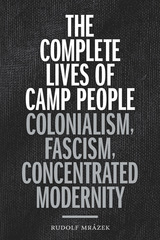 The Complete Lives of Camp People: Colonialism, Fascism, Concentrated Modernity
Rudolf Mrázek
Duke University Press, 2020 In The Complete Lives of Camp People Rudolf Mrázek presents a sweeping study of the material and cultural lives of twentieth-century concentration camp internees and the multiple ways in which their experiences speak to the fundamental logics of modernity. Mrázek focuses on the minutiae of daily life in two camps: Theresienstadt, a Nazi “ghetto” for Jews near Prague, and the Dutch “isolation camp” Boven Digoel—which was located in a remote part of New Guinea between 1927 and 1943 and held Indonesian rebels who attempted to overthrow the colonial government. Drawing on a mix of interviews with survivors and their descendants, archival accounts, ephemera, and media representations, Mrázek shows how modern life's most mundane tasks—buying clothes, getting haircuts, playing sports—continued on in the camps, which were themselves designed, built, and managed in accordance with modernity's tenets. In this way, Mrázek demonstrates that concentration camps are not exceptional spaces; they are the locus of modernity in its most distilled form.
 The Complete Notebooks
Albert Camus
University of Chicago Press, 2025 The first complete translation of Albert Camus’s personal notebooks written between 1933 and 1959, published for the first time in one comprehensive volume.
Throughout his career, French writer and philosopher Albert Camus kept a series of notebooks that offers an unrivaled glimpse into the writer at his most personal and reflective. These notebooks contain his thoughts on politics, solitude, personal failings and regrets, his travels, and his relationships with friends and rivals. They also provide insight into his process as a thinker—his frustrations, his ideas for novels and plays (some pursued and others abandoned), his routines, his aspirations, and his self-recriminations.
For Camus devotees, there is no more intimate experience than reading these notebooks. On the one hand, his fallibility is on full display: He is irritated by mediocrity, frustrated with his health, plagued by insomnia, and miserable about life’s petty necessities. Yet, he is also intensely curious and observant, sometimes moved to rapture by landscapes and people. Readers will experience the bounty of Camus’s philosophical imagination and witness firsthand how his ideas take shape. The notebooks contain drafts of letters to friends and recorded reflections on the compromises that being in the world demands.
This publication marks the first time Camus’s complete notebooks have been published in one comprehensive volume. Expertly and movingly translated by Ryan Bloom with extensive footnotes contextualizing the entries, The Complete Notebooks will remain a literary treasure for years to come.
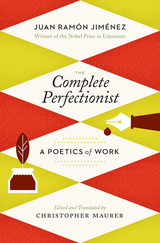 The Complete Perfectionist: A Poetics of Work
Juan Ramón Jiménez
Swan Isle Press, 2011 Few have written more memorably about the work of poetry and the poetics of work than Juan Ramón Jiménez, winner of a Nobel Prize and discerning teacher of an entire generation of Spanish poets. In this series of aphorisms, Jiménez brings together the elements of perfect work, both in writing and in other realms. Among these elements—the wellsprings of any kind of creation—are instinct and inspiration, memory and forgetting, silence and noise, love and regret. A treasure for poets and writers, The Complete Perfectionist includes helpful commentary by noted translator Christopher Maurer and shows perfection as a process of “becoming” rather than an end product. In these insightful pages, a poet haunted by perfection reveals his methods of writing and revision, and measures the social and ethical dimensions of el trabajo gustoso, or pleasurable work. This revised and expanded edition includes many aphorisms recently published in Spanish and not previously included.
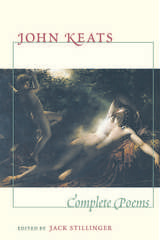 Complete Poems
John Keats
Harvard University Press, 1991 Here is the first reliable edition of John Keats’s complete poems designed expressly for general readers and students.
Upon its publication in 1978, Jack Stillinger’s The Poems of John Keats won exceptionally high praise: “The definitive Keats,” proclaimed The New Republic—“An authoritative edition embodying the readings the poet himself most probably intended, prepared by the leading scholar in Keats textual studies.”
Now this scholarship is at last available in a graceful, clear format designed to introduce students and general readers to the “real” Keats. In place of the textual apparatus that was essential to scholars, Stillinger here provides helpful explanatory notes. These notes give dates of composition, identify quotations and allusions, gloss names and words not included in the ordinary desk dictionary, and refer the reader to the best critical interpretations of the poems. The new introduction provides central facts about Keats’s life and career, describes the themes of his best work, and speculates on the causes of his greatness.
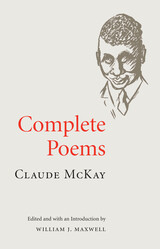 Complete Poems
Claude Mckay. Edited and with an Introduction by William J. Maxwell.
University of Illinois Press, 2003 Containing more than three hundred poems, including nearly a hundred previously unpublished works, this unique collection showcases the intellectual range of Claude McKay (1889-1948), the Jamaican-born poet and novelist whose life and work were marked by restless travel and steadfast social protest. McKay's first poems were composed in rural Jamaican creole and launched his lifelong commitment to representing everyday black culture from the bottom up. Migrating to New York, he reinvigorated the English sonnet and helped spark the Harlem Renaissance with poems such as "If We Must Die." After coming under scrutiny for his communism, he traveled throughout Europe and North Africa for twelve years and returned to Harlem in 1934, having denounced Stalin's Soviet Union. By then, McKay's pristine "violent sonnets" were giving way to confessional lyrics informed by his newfound Catholicism. McKay's verse eludes easy definition, yet this complete anthology, vividly introduced and carefully annotated by William J. Maxwell, acquaints readers with the full transnational evolution of a major voice in twentieth-century poetry.
 Complete Poems
Edgar Allan Poe
University of Illinois Press, 1969 Although best known for his tales, Edgar Allan Poe himself thirsted for fame primarily as a poet. This volume, assembled by the eminent Poe scholar Thomas Ollive Mabbott, is the single most authoritative edition of Poe's poems ever published: 101 poems and their variants, including such gems as "The Raven," "The Bells," and "Annabel Lee," as well as previously uncollected poems, fragments, verses he published in reviews he wrote, and poems attributed to him.
In this exhaustive collection, Mabbott takes a fresh look at these texts, aiming "to present what [Poe] wrote, to explain why he wrote it, to tell what he meant when he wrote it (if that be in any way obscure), and to give a history of its publication." Containing the definitive poems as well as pertinent biographical background, full annotations, and a meticulous enumeration of successive texts and variants, Mabbott's edition stands as a firm foundation for Poe scholarship as well as for more general appreciation.
Complete Poems: A Bilingual Edition
Veronica Gambara
Iter Press, 2014 Veronica Gambara (1485–1550) was one of the most celebrated lyric poets of early sixteenth-century Italy. Equally significant to Gambara’s literary repute was her political standing as the dowager Countess of Correggio. Though she never published a collected edition of her poetry, Gambara produced an extensive oeuvre of vernacular verse that has been extensively anthologized. This book presents the first complete bilingual edition of Gambara’s verse. It sheds light on the unique interrelationship between Gambara’s cultural currency and her political power, as she drew on her literary talent to participate in the political arena to emerge as one of the first women poet-rulers of the Early Modern Italian tradition.
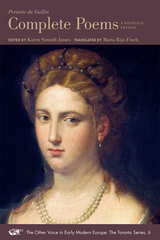 Complete Poems. A Bilingual Edition
Pernette du Guillet
Iter Press, 2010 In 1545, the first edition of the Rymes presented the young Pernette du Guillet as a model of feminine virtue and learning for other ladies to emulate. Pernette du Guillet has long been identified as muse and pupil of Maurice Scève in Lyon’s lively literary circle. Such views have profoundly shaped the reading of her work, yet the poems themselves reveal complex responses to lyric traditions and theories of love that influenced many Renaissance writers. Du Guillet transforms those conventions in a unique voice, moving beyond the silence imposed on sixteenth-century women. Expressing admiration and jealousy, awe and dismay, solemnity and playfulness, confusion and confidence, her poems bring to life a young woman’s experience with love and her development as a writer.
This first complete English edition provides a fully-annotated bilingual text and a fresh perspective from which to appreciate the originality and beauty of this poetry.
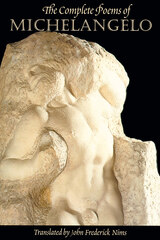 The Complete Poems of Michelangelo
Michelangelo
University of Chicago Press, 1998 There is no artist more celebrated than Michelangelo. Yet the magnificence of his achievements as a visual artist often overshadow his devotion to poetry. Michelangelo used poetry to express what was too personal to display in sculpture or painting. John Frederick Nims has brought the entire body of Michelangelo's verse, from the artist's ardent twenties to his anguished and turbulent eighties, to life in English in this unprecedented collection. The result is a tantalizing glimpse into a most fascinating mind.
"Wonderful. . . . Nims gives us Michelangelo whole: the polymorphous love sonneteer, the political allegorist, and the solitary singer of madrigals."—Kirkus Reviews
"A splendid, fresh and eloquent translation. . . . Nims, an eminent poet and among the best translators of our time, conveys the full meaning and message of Michelangelo's love sonnets and religious poems in fluently rhymed, metrical forms."—St. Louis Post-Dispatch
"The best so far. . . . Nims is best at capturing the sound and sense of Michelangelo's poetic vocabulary."—Choice
"Surely the most compelling translations of Michelangelo currently available in English."—Ronald L. Martinez, Washington Times
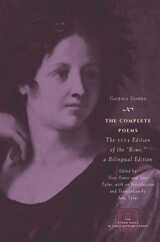 The Complete Poems: The 1554 Edition of the "Rime," a Bilingual Edition
Gaspara Stampa
University of Chicago Press, 2010 Gaspara Stampa (1523?-1554) is one of the finest female poets ever to write in Italian. Although she was lauded for her singing during her lifetime, her success and critical reputation as a poet emerged only after her verse was republished in the early eighteenth century. Her poetry runs the gamut of human emotion, ranging from ecstasy over a consummated love affair to despair at its end. While these tormented works and their multiple male addressees have led to speculation that Stampa may have been one of Venice’s famous courtesans, they can also be read as a rebuttal of typical assumptions about women’s roles. Championed by Rainer Maria Rilke, among others, she has more recently been celebrated by feminist scholars for her distinctive and original voice and her challenge to convention.
The first complete translation of Stampa into English, this volume collects all of her passionate and lyrical verse. It is also the first modern critical edition of her poems, and in restoring the original sequence of the 1554 text, it allows readers the opportunity to encounter Stampa as she intended. Jane Tylus renders Stampa’s verse in precise and graceful English translations, allowing a new generation of students and scholars of poetry, Renaissance literature, and music history to rediscover this incipiently modern Italian poet.
Complete Poetry and Prose: A Bilingual Edition
Louise Labé
University of Chicago Press, 2006 Thanks to her acclaimed volume of poetry and prose published in France in 1555, Louise Labé (1522-66) remains one of the most important and influential women writers of the Continental Renaissance. Best known for her exquisite collection of love sonnets, Labé played off the Petrarchan male tradition with wit and irony, and her elegies respond with lyric skill to predecessors such as Sappho and Ovid. The first complete bilingual edition of this singular and broad-ranging female author, Complete Poetry and Prose also features the only translations of Labé's sonnets to follow the exacting rhyme patterns of the originals and the first rhymed translation of Labé's elegies in their entirety.
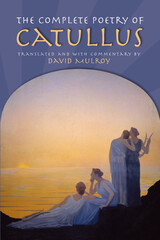 The Complete Poetry of Catullus
Catullus; Translated and with commentary by David Mulroy
University of Wisconsin Press, 2002 Catullus’ life was akin to pulp fiction. In Julius Caesar’s Rome, he engages in a stormy affair with a consul’s wife. He writes her passionate poems of love, hate, and jealousy. The consul, a vehement opponent of Caesar, dies under suspicious circumstances. The merry widow romances numerous young men. Catullus is drawn into politics and becomes a cocky critic of Caesar, writing poems that dub Julius a low-life pig and a pervert. Not surprisingly, soon after, no more is heard of Catullus.
David Mulroy brings to life the witty, poignant, and brutally direct voice of a flesh-and-blood man, a young provincial in the Eternal City, reacting to real people and events in a Rome full of violent conflict among individuals marked by genius and megalomaniacal passions. Mulroy’s lively, rhythmic translations of the poems are enhanced by an introduction and commentary that provide biographical and bibliographical information about Catullus, a history of his times, a discussion of the translations, and definitions and notes that ease the way for anyone who is not a Latin scholar.
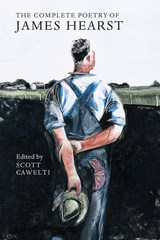 The Complete Poetry of James Hearst
James Hearst
University of Iowa Press, 2001
"James Hearst wrote eloquently of the land, its pleasures and sorrows, carefully turning the language as one of his farmer heroes turns the soil. Scott Cawelti and his colleagues have done us all a favor by assembling this fine collection, ensuring the onward resonance of Hearst's words and sensibilities."--Robert James Waller
" 'Write about what you know!' was the only advice given by the shy published poet to the shy girl who walked from her college to his farm, having begun to discover what she knew by crafting poems. Surely James Hearst knew pain and loss in plenty, but once he had sworn never again to 'uncover [his] door' to this kind of 'rain,' the world pitchforked its bounties to him through every window available to a poet. The results run from the perfect early nature lyric, 'Blue Again,' to the moving and rich domestic wisdom of 'Close Call.' This book is a late, uneven harvest, but a fine one."--Mona Van Duyn, U.S. Poet Laureate, 1992-1993
Part of the regionalist movement that included Grant Wood,
SCOTT CAWELTI is professor of English at the University of Northern Iowa. He is the author of The Inventive Writer and Introduction to College Writing. He also writes a weekly column for the Waterloo Courier and has been a commentator for National Public Radio.
In keeping with the tradition of small regional presses and fine printers-especially Prairie Press, which published Hearst's poetry throughout his lifetime-this edition was designed in collaboration with the University of Iowa Center for the Book.
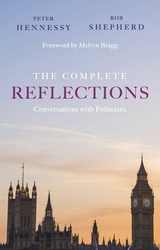 The Complete Reflections: Conversations with Politicians
Peter Hennessy and Robert Shepherd
Haus Publishing, 2020 On the BBC radio show Reflections with Peter Hennessy, the preeminent historian of British political life interviewed leading figures from the UK’s governing parties during the late twentieth and early twenty-first centuries. Bringing together transcripts of the collected interviews for the first time, The Complete Reflections features interviews the biggest names from the Thatcher era, the New Labour years, and the coalition government of the 2010s.
In The Complete Reflections, Peter Hennessy and Robert Shepherd provide not only an overview of the past three decades of British politics but also delve into the minds of those at the forefront of public life during times of great change. Hennessy’s deep knowledge and understanding of the lives and motivations of his interviewees, along with the obvious esteem in which they hold their interlocutor, leads to frank and revealing conversations in which the subject is not an object but an equal, giving these exchanges a unique veracity. The results are portraits of high authority, in which interviews become the chronicles that endure above all others—nothing less than the first draft of history.
The Complete Sermons of Ralph Waldo Emerson, Volume 1
Ralph Waldo Emerson, Edited by Albert J. von Frank, Intro by David M. Robinson
University of Missouri Press, 1989 This inaugural volume of a four-volume set marks the beginning of the publication of all 180 of the extant sermons composed and delivered by Emerson between the start of his ministerial career in 1826 and his final retirement from the pulpit in 1838. Edited from manuscripts in the Houghton Library, Harvard University, the sermons are presented in chronological order in a clear text approximating as nearly as possible the original version read by Emerson to his congregation. The historical introduction by David M. Robinson gives a significant appraisal of Emerson's life between 1826 and 1838 and of his absorption in and reaction against the religious culture of his time.
The Complete Sermons of Ralph Waldo Emerson, Volume 2
Ralph Waldo Emerson, Edited by Teresa Toulouse & Andrew H. Delbanco & Series Editor Albert J. von Frank
University of Missouri Press, 1990 Volume 2 includes a detailed chronology of the events in Emerson's life during the months between July 1829 and October 1830. Explanatory footnotes, textual endnotes, and a comprehensive index further add to this significant contribution to our understanding of one of America's foremost thinkers.
The Complete Sermons of Ralph Waldo Emerson, Volume 3
Ralph Waldo Emerson; Edited by Ronald A. Bosco; Chief Editor, Albert J. von Frank
University of Missouri Press, 1991 The forty-five sermons collected in Volume 3 were composed and first delivered between October 1830 and November 1831. During that time Emerson's first wife, Ellen Tucker Emerson, died of tuberculosis, a loss that deeply affected Emerson. Transcribed and edited from manuscripts in Harvard's University's Houghton Library, the sermons are presented in a clear text approximating as nearly as possible the original version delivered to Emerson's congregation. As well as the detailed chronology, explanatory footnotes, and textual endnotes found in previous volumes, this one contains a comprehensive index.
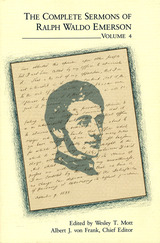 The Complete Sermons of Ralph Waldo Emerson, Volume 4
Ralph Waldo Emerson, Edited by Wesley T. Mott, Series Editor Albert J. von Frank
University of Missouri Press, 1992 The final volume in the series focuses on a crossroads in Emerson's life, the year 1832, when he resigned from his ministry at the Second Church of Boston. It includes a new and more accurate text of the single most important of Emerson's sermons, "The Lord's Supper Sermon." For the first time, this sermon has been transcribed from the manuscript Emerson actualy read from on the occasion of its only delivery. The sermon was not only pivotal in Emerson's career, it was historically important because of the controversy that ensued over formalism in religion. Volume 4 presents annotated texts of eight occasional sermons in addition to twenty-seven regular sermons, and an annotated text of relevant portions of the official records of the Second Church of Boston during Emerson's ministry. The sermons-most appearing in print for the first time-provide a thorough understanding of the evolution of Emerson's thought in the years immediately preceding the 1836 publication of Nature, a treatise of central importance to nineteenth-century American literature. Transcribed and edited from manuscripts in Harvard's University's Houghton Library, the sermons are presented in a clear text approximating as nearly as possible the original version delivered to Emerson's congregation. As well as the detailed chronology, explanatory footnotes, and textual endnotes found in previous volumes, this one contains a comprehensive index to the entire four-volume collection. Such outstanding textual scholarship makes this edition a unique entrance into the spiritual life of a man who so profoundly influenced American thought.
 The Complete Short Stories, Volume 1
Enid Dinnis
Catholic University of America Press, 2023 Gathered here for the first time are the stories of Enid Dinnis, who lived and wrote in London throughout the first half of the 20th century. Enid Dinnis moved widely in the London literary world but she was also Mother Superior of a ‘hidden’ religious order, The Daughters of the Heart of Mary. Few in London’s literary scene knew that Dinnis was a nun but she lived most of her life in a small convent in Wimbledon with other well-known figures from the period, including Maud Petre. Dinnis wrote Catholic stories for readers of all ages. She is one of the finest lost authors of the Catholic Literary Revival. Dinnis’s intervention in the short story genre is considerable. She weaves together fairy tale, myth, Catholic mysticism, epiphanic dialogue and everyday characterization to produce stories that are both simple and complex, both light-hearted and profound. Always concerned with ‘the wonderful resourcefulness of the love of God’, her stories proclaim the presence and workings of divine grace in the everyday lives of all people—old and young, sceptics and seekers, farmers and priests. Dinnis’s stories show that God’s love is the answer to all human struggles and quests. They illustrate what it means to receive love – human and divine – and to pass it on. Her work is filled with visions and confessions, miracles and conversions – but it is never overly pious or saccharine. Her characters are real people experiencing the truths proclaimed by the Catholic faith, which is always as marvelous as it is every-day. Enid Dinnis’s stories reenchant the post-enlightenment world along Catholic lines. Her stories put the supernatural firmly back into the world in a way more needed than ever.
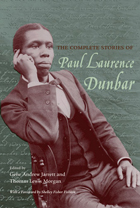 The Complete Stories of Paul Laurence Dunbar
Paul Laurence Dunbar
Ohio University Press, 2005 An ALA “Best of the Best” Book The son of former slaves, Paul Laurence Dunbar was one of the most prominent figures in American literature at the turn of the twentieth century. Thirty-three years old at the time of his death in 1906, he had published four novels, four collections of short stories, and fourteen books of poetry, as well as numerous songs, plays, and essays in newspapers and magazines around the world.
In the century following his death, Dunbar slipped into relative obscurity, remembered mainly for his dialect poetry or as a footnote to other more canonical figures of the period. The Complete Stories of Paul Laurence Dunbar showcases his gifts as a writer of short fiction and provides key insights into the tensions and themes of Dunbar's literary achievement. The 104 stories written by Dunbar between 1890 and 1905 reveal Dunbar's attempts to maintain his artistic integrity while struggling with America's racist stereotypes. Making them available for the first time in one convenient, comprehensive, and definitive volume, The Complete Stories of Paul Laurence Dunbar illustrates the complexity of his literary life and legacy.
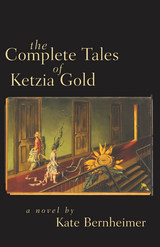 The Complete Tales of Ketzia Gold
Kate Bernheimer
University of Alabama Press, 2001 The Complete Tales of Ketzia Gold is a lavishly poetic novel that draws upon the motifs of traditional German, Russian and Yiddish folklore and fairy stories to recount the visionary obsessions of a passionate young woman.
The Complete Tales of Ketzia Gold is a lavishly poetic novel that draws upon the motifs of traditional German, Russian and Yiddish folklore and fairy stories to recount the visionary obsessions of a passionate young woman. The narrative moves freely through time and space, uniting Ketzia Gold's early childhood with her sexual awakenings, creating a dreamscape of haunting vividness. Marked by a logical illogic and disarmingly sane madness, this haunting and innovative fable creates an emotional landscape that's as impossible to escape as it is for young Ketzia to inhabit. Kate Bernheimer interweaves hypnotic imagery and everyday life, moving back and forth through time, piecing together the fragments of memory and imagination with an obsessive lyricism that recalls the poetic fictions of Carol Maso. Bernheimer's story is a rich tapestry, patterned with childhood longings and the luxuriant complexity of womanhood.
The Complete Tales of Lucy Gold
Kate Bernheimer
University of Alabama Press, 2011 As a child, Lucy dreams of talking fairies and lives contentedly in the wooded suburbs of Boston; she grows up to be a successful animator of fairy-tale films. Or does she? She claims at moments to be a witch in the woods. Like her sisters, who appeared in Bernheimer’s first two novels (The Complete Tales of Ketzia Gold and The Complete Tales of Merry Gold), Lucy has a secret, but she is unable to fasten onto anything but brightness. Novelist Donna Tartt writes, “Lucy’s particular brand of optimism, blind to its own shadow, is very American—she is innocence holding itself apart so fastidiously that it becomes its opposite.” This novel is a perfect end to the Gold family series, and the perfect introduction, for new readers, to Bernheimer’s enchanting body of work.
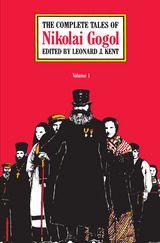 The Complete Tales of Nikolai Gogol, Volume 1
Nikolai Gogol
University of Chicago Press, 1985 Nikolai Gogol was an artist who, like Rabelais, Cervantes, Swift, and Sterne, "knew how to walk upside down in our valley of sorrows so as to make it to a merry place." This two-volume edition at last brings all of Gogol's fiction (except his novel Dead Souls) together in paperback. Volume 1 includes Evenings on a Farm near Dikanka, the early Ukrainian folktales that first brought Gogol fame, as well as "Nevsky Prospekt" and "Diary of a Madman."
"It is good to have a complete collection of Gogol's tales in paperback. . . . Professor Kent has thoroughly revised Mrs. Garnett's conscientious and skillful translation, eliminating the Victorianisms of her style, correcting mistakes and pruderies of diction, and making the whole translation sound much more contemporary and alive. But he has avoided the whimsicality and 'curliness' in which some recent translators indulged, and he has not changed or suppressed anything material. He has also supplied helpful notes which are often the first annotation in English, and he has written an introduction which steers the correct middle course between making Gogol an irresponsible artist of the grotesque and proving him a documentary historian of backward Russia."—René Wellek, Yale University
The Complete Tales of Nikolai Gogol, Volume 2
Nikolai Gogol
University of Chicago Press, 1983 Volume 2 of The Complete Tales includes Gogol's Mirgorod stories—among them that masterpiece of grotesque comedy, "The Tale of How Ivan Ivanovich Quarreled with Ivan Nikiforovich," the wonderfully satiric "Old World Landowners," and the Cossak epic "Taras Bulba." Here also is "The Nose," Gogol's final effort in the realm of the fantastic, as well as "The Coach," "The Portrait" (in its final version), and the most influential of his Petersburg stories, "The Overcoat."
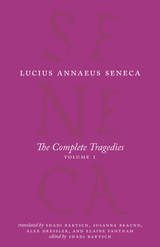 The Complete Tragedies, Volume 1: Medea, The Phoenician Women, Phaedra, The Trojan Women, Octavia
Lucius Annaeus Seneca
University of Chicago Press, 2017 The complete tragic works of the leading Stoic philosopher and playwright
Edited by world-renowned classicists Elizabeth Asmis, Shadi Bartsch, and Martha C. Nussbaum, the Complete Works of Lucius Annaeus Seneca series offers authoritative, modern English translations of the writings of the Stoic philosopher and playwright (4 BCE–65 CE). The two volumes of The Complete Tragedies present all of his dramas, expertly rendered by preeminent scholars and translators.
This first volume contains Medea, The Phoenician Women, Phaedra, The Trojan Women, and Octavia, the last of which was written in emulation of Senecan tragedies and serves as a unique example of political tragedy. High standards of accuracy, clarity, and style are maintained throughout the translations, which render Seneca into verse with as close a correspondence, line for line, to the original as possible, and with special attention paid to meter and overall flow. In addition, each tragedy is prefaced by an original translator’s introduction offering reflections on the work’s context and meaning. Notes are provided for the reader unfamiliar with the culture and history of classical antiquity. Accordingly, The Complete Tragedies will be of use to a general audience and professionals alike, from the Latinless student to scholars and instructors of comparative literature, classics, philosophy, drama, and more.
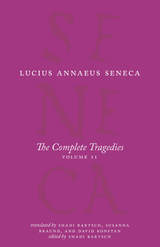 The Complete Tragedies, Volume 2: Oedipus, Hercules Mad, Hercules on Oeta, Thyestes, Agamemnon
Lucius Annaeus Seneca
University of Chicago Press, 2017 The complete tragic works of the leading Stoic philosopher and playwright
Edited by world-renowned classicists Elizabeth Asmis, Shadi Bartsch, and Martha C. Nussbaum, the Complete Works of Lucius Annaeus Seneca offers authoritative, modern English translations of the writings of the Stoic philosopher and playwright (4 BCE–65 CE). The two volumes of The Complete Tragedies presents all of his dramas, expertly rendered by preeminent scholars and translators.
The first volume contains Medea, The Phoenician Women, Phaedra, The Trojan Women, and Octavia, the last of which was written in emulation of Senecan tragedies and serves as a unique example of political tragedy. This second volume includes Oedipus, Hercules Mad, Hercules on Oeta, Thyestes, and Agamemnon. High standards of accuracy, clarity, and style are maintained throughout the translations, which render Seneca into verse with as close a correspondence, line for line, to the original as possible, and with special attention paid to meter and overall flow. In addition, each tragedy is prefaced by an original translator’s introduction offering reflections on the work’s context and meaning. Notes are provided for the reader unfamiliar with the culture and history of classical antiquity. Accordingly, The Complete Tragedies will be of use to a general audience and professionals alike, from the Latinless student to scholars and instructors of comparative literature, classics, philosophy, drama, and more.
The Complete Vegetarian: The Essential Guide to Good Health
Edited by Peggy Carlson M.D.
University of Illinois Press, 2009 The Complete Vegetarian makes important scientific connections between good health and vegetarianism after citing health concerns as the number one reason many people adopt a vegetarian diet. Peggy Carlson examines the vegetarian diet’s impact on chronic diseases and serves as a nutritional guide and meal-planning resource for many health professionals and regular consumers. Vegetarian nutritionists’ and medical doctors’ cutting-edge research find that an absence of meat is the only factor that accounts for the health effects of a vegetarian diet, but also a lower saturated fat and more fiber, antioxidants, and unsaturated fat count than other diets. Essential and in-depth The Complete Vegetarian is an invaluable guide for health professionals and the growing number of people who have adopted or want to adopt a vegetarian lifestyle.
Complete Works and Other Stories
By Augusto Monterroso
University of Texas Press, 1995 Augusto Monterroso is widely known for short stories characterized by brilliant satire and wit. Yet behind scathing allusions to the weaknesses and defects of the artistic and intellectual worlds, they show his generous and expansive sense of compassion. This book brings together for the first time in English the volumes Complete Works (and Other Stories) (Obras completas [y otros cuentos] 1959) and Perpetual Motion (Movimiento perpetuo 1972). Together, they reveal Monterroso as a foundational author of the new Latin American narrative.
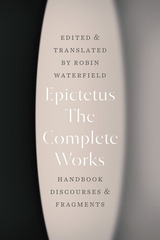 The Complete Works: Handbook, Discourses, and Fragments
Epictetus
University of Chicago Press, 2022 The complete surviving works of Epictetus, the most influential Stoic philosopher from antiquity.
“Some things are up to us and some are not.”
Epictetus was born into slavery around the year 50 CE, and, upon being granted his freedom, he set himself up as a philosophy teacher. After being expelled from Rome, he spent the rest of his life living and teaching in Greece. He is now considered the most important exponent of Stoicism, and his surviving work comprises a series of impassioned discourses, delivered live and recorded by his student Arrian, and the Handbook, Arrian’s own take on the heart of Epictetus’s teaching.
In Discourses, Epictetus argues that happiness depends on knowing what is in our power to affect and what is not. Our internal states and our responses to events are up to us, but the events themselves are assigned to us by the benevolent deity, and we should treat them—along with our bodies, possessions, and families—as matters of indifference, simply making the best use of them we can. Together, the Discourses and Handbook constitute a practical guide to moral self-improvement, as Epictetus explains the work and exercises aspirants need to do to enrich and deepen their lives. Edited and translated by renowned scholar Robin Waterfield, this book collects the complete works of Epictetus, bringing to modern readers his insights on how to cope with death, exile, the people around us, the whims of the emperor, fear, illness, and much more.
CUSTOMER NOTE: THE HARDCOVER IS FOR LIBRARIES AND HAS NO JACKET.
The Complete Works of Liudprand of Cremona (Medieval Texts in Translation)
Liudprand of Cremona
Catholic University of America Press, 2007 This modern English translation of all the surviving literary compositions ascribed to Liudprand, the bishop of Cremona from 962 to 972, offers unrivaled insight into society and culture in western Europe during the "iron century."
 The Complete Works of Robert Browning Volume I: With Variant Readings And Annotations
Robert Browning
Ohio University Press, 1969 In seventeen volumes, copublished with Baylor University, this acclaimed series features annotated texts of all of Robert Browning’s known writing. The series encompasses autobiography as well as influences bearing on Browning’s life and career and aspects of Victorian thought and culture. Volume I contains two dramatic poems, Pauline; A Fragment of a Confession and Paracelsus, along with a sonnet, “Eyes Calm Beside Thee.” Pauline was written in 1832 and published in March 1833, London: Saunders and Otley, Conduit Street. Browning’s principal source material for Paracelsus was Frederick Bitiskius’s edition of the works of Paracelsus, the early Renaissance alchemist, mystic, and physician; as well as the article on Paracelsus in the Biographie Universelle. E. D. H. Johnson wrote that in Paracelsus, “Browning first attacks the problem of communication, while still insisting on the primacy of the intuitions over the rational intellect. Paracelsus is a study of intellectual pride and its humbling.” As always in this acclaimed series, a complete record of textual variants is provided, as well as extensive explanatory notes.
 The Complete Works of Robert Browning, Volume II: With Variant Readings And Annotations
Robert Browning
Ohio University Press, 1971 In seventeen volumes, copublished with Baylor University, this acclaimed series features annotated texts of all of Robert Browning’s known writing. The series encompasses autobiography as well as influences bearing on Browning’s life and career and aspects of Victorian thought and culture. Volume II contains Browning’s play, Strafford: An Historical Tragedy (1837), and the long poem, Sordello (1840). Strafford was Browning’s first play, based on the tragic life of Thomas Wentworth, Earl of Strafford. The editors note that the play had only four performances, “undoubtedly due… to its esoteric subject and bad acting.” Sordello is a fictionalized version of the life of Sordello da Goito, a 13th century Italian troubadour. The poem itself was famously known for being “difficult.” As always in this acclaimed series, a complete record of textual variants is provided, as well as extensive explanatory notes.
 The Complete Works of Robert Browning, Volume III: With Variant Readings And Annotations
Robert Browning
Ohio University Press, 1972 In seventeen volumes, copublished with Baylor University, this acclaimed series features annotated texts of all of Robert Browning’s known writing. The series encompasses autobiography as well as influences bearing on Browning’s life and career and aspects of Victorian thought and culture. Volume III contains Browning’s dramatic piece, Pippa Passes (1841), which Arthur Symons said was “Browning’s most perfect work”; another play King Victor and King Charles; A Tragedy, which Browning described as “the first artistic consequence of what Voltaire termed ‘a terrible event without consequences‘“; the “Essay on Chatterton,” which appeared anonymously in the Foreign Quarterly Review in July, 1842; the play The Return of the Druses: A Tragedy (1843); and the short pieces of Dramatic Lyrics, which contain some of Browning’s finest and most popular works such as “My Last Duchess,” “The Soliloquy of the Spanish Cloister,” and “The Pied Piper of Hamelin.” As always in this acclaimed series, a complete record of textual variants is provided, as well as extensive explanatory notes.
The Complete Works of Robert Browning, Volume V: With Variant Readings and Annotations
Roma A. King Jr.
Ohio University Press, 1981 In seventeen volumes, copublished with Baylor University, this acclaimed series features annotated texts of all of Robert Browning’s known writing. The series encompasses autobiography as well as influences bearing on Browning’s life and career and aspects of Victorian thought and culture. Volume V contains: A Soul’s TragedyPoemsChristmas-Eve and Easter DayEssay on ShelleyMen and Women, Vol. I As always in this acclaimed series, a complete record of textual variants is provided, as well as extensive explanatory notes.
 The Complete Works of Robert Browning, Volume VI: With Variant Readings and Annotations
Robert Browning
Ohio University Press, 1996 In seventeen volumes, copublished with Baylor University, this acclaimed series features annotated texts of all of Robert Browning’s known writing. The series encompasses autobiography as well as influences bearing on Browning’s life and career and aspects of Victorian thought and culture. The sixth in the projected seventeen-volume work, this volume covers the second half of Men and Women (1855), perhaps Browning’s most famous collection, and the entirety of Dramatis Personae (1864), the first book Browning produced after the death of Elizabeth Barrett Browning in 1861. Men and Women II contains several great dramatic poems on which Browning’s reputation still depends, including “Andrea del Sarto,” “Saul,” and “Cleon.” It also includes the more intimate and personal works “The Guardian Angel” and “One Word More,” as well as the mysterious “Women and Roses.” The Brownings‘ shared interests in Renaissance art and nineteenth-century Italian politics inform the challenging “Old Pictures in Florence.” The publication of Dramatis Personae was a key event in the rapid rise of Browning’s fame in the 1860s, though the collection is marked by a welter of conflicting impulses that arose after the poet left Italy and his married life behind. The classic monologues “Rabbi Ben Ezra” and “Abt Vogler” are here, but beside them Browning placed the nearly surreal “Caliban upon Setebos” and the achingly self-regarding “James Lee’s Wife,” one of the volume’s handful of dramatic lyrics about betrayed or failed relationships. Also included are “A Death in the Desert,” which contributed to the intense Victorian debate about scriptural validity and religious authority; and “Mr Sludge, ’The Medium,‘” Browning’s ferocious, pyrotechnic exposé of a spiritualist fraud. As always in this acclaimed series, a complete record of textual variants is provided, as well as extensive explanatory notes.
 The Complete Works of Robert Browning, Volume VII: With Variant Readings and Annotations
Robert Browning
Ohio University Press, 1985 The first complete edition of the works of Robert Browning with variant readings and annotations contains: 1. The entire contents of the first editions of Browning’s work; 2. All prefaces and dedications which Browning wrote for his own works and for those of Elizabeth Barrett Browning and others; 3. The two prose essays: The Essay on Chatterton and The Essay on Shelley; 4. The front matter and tables of contents of each of the collected editions (1849, 1863, 1865, 1868, 1888–1889) which Browning himself saw through the press; 5 Poems by Browning published during his lifetime but not collected by him; 9. Poems not published during Browning’s lifetime which have come to light since his death; 7. John Forster’s Thomas Wentworth, Earl of Strafford to which Browning contributed significantly, though to what precise extent has not been determined. The edition provides a full apparatus, including variant readings and annotations.
 The Complete Works of Robert Browning, Volume X: With Variant Readings and Annotations
Robert Browning
Ohio University Press, 1999 The Complete Works of Robert Browning, Volume X contains critical editions of Balaustion's Adventure: Including a Transcript from Euripides and Prince Hohenstiel-Schwangau, Saviour of Society. Both published in 1871, these two long poems take up a pair of subjects that held enduring fascination for Robert and Elizabeth Barrett Browning: classical Greek literature and the career of Napoleon III, Emperor of France. Balaustion's Adventure, which the poet characterized as merely a “May-month amusement,” was surprisingly successful with the reading public that paid more attention to Browning after the triumph of The Ring and the Book in 1868-69. His first poem since the publication of that masterpiece, Balaustion's Adventure creates a charming and brave narrator who recalls in vivid detail a performance of Euripides' play Alcestis.
Browning began a poem on Louis Napoleon in 1860, but not until after the fall of the Second Empire in 1870 did he attempt a full-scale portrait of the French emperor. As an exercise in self-justification, Prince Hohenstiel-Schwangau falls into a familiar sub-genre of Browning's dramatic monologues. The most intriguing aspect of the poem lies in its biographical importance: the character and career of Napoleon III was a topic of sustained, sharp disagreement between Robert and Elizabeth Browning.
As always in this acclaimed series, a complete record of textual variants is provided, as well as extensive explanatory notes.
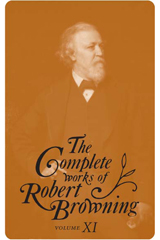 The Complete Works of Robert Browning, Volume XI: With Variant Readings and Annotations
Robert Browning
Ohio University Press, 2008 In seventeen volumes, copublished with Baylor University, this acclaimed series features annotated texts of all of Robert Browning’s known writing. The series encompasses autobiography as well as influences bearing on Browning’s life and career and aspects of Victorian thought and culture.
Volume XI of The Complete Works of Robert Browning contains two strikingly disparate long poems from the 1870s, Fifine at the Fair and Red Cotton Night-Cap Country. In Fifine at the Fair, Browning creates an idiosyncratic version of the Don Juan figure, a distinctly post-Romantic and intellectual Don Juan who derives little from any literary predecessor. The legendary character is realized in a modern French setting, the village of Pornic, a favorite vacation spot for Browning. The poem is a sustained exercise in self-justification and casuistry, with Don Juan persuading himself that he can reconcile his love of his wife with his carnal love for a gipsy girl.
Though Red Cotton Night-Cap Country is similarly concerned with a struggle between spirit and flesh, the poem is entirely based in contemporary events. Using newspaper accounts and legal documents, Browning tells the strange and shocking tale of a rich and devout Frenchman who throws himself from the roof of his chateau, convinced that heaven will deliver him from death. Upon the question of his sanity hinges the disposition of his considerable estate, and the poet traces the claims and counterclaims to their settlement in court only a few months before he wrote the poem.
As always in this series of critical editions, a complete record of textual variants is provided, as well as extensive explanatory notes.
 The Complete Works of Robert Browning, Volume XIV: With Variant Readings and Annotations
Robert Browning
Ohio University Press, 2003 In seventeen volumes, copublished with Baylor University, this acclaimed series features annotated texts of all of Robert Browning’s known writing. The series encompasses autobiography as well as influences bearing on Browning’s life and career and aspects of Victorian thought and culture. Volume XIV of The Complete Works of Robert Browning records a transition in the poet’s career. With The Agamemnon of Aeschylus (1877), Browning ended his experiments with classical sources, creating his “transcript” — not quite a translation — of the Greek original and providing an intriguing explanation for his approach. La Saisiaz, the deeply personal expression of Browning’s shock at the sudden death of a dear friend, was published in 1878 with The Two Poets of Croisic, an extended ironic meditation on literary fame. Browning’s collection of six poems under the title Dramatic Idyls (1879) marks the poet’s return to the dramatic forms he perfected in Men and Women and Dramatis Personae, and a revival of his interest in the psychology of motives. As always in this acclaimed series, a complete record of textual variants is provided, as well as extensive explanatory notes.
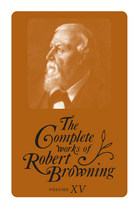 The Complete Works of Robert Browning, Volume XV: With Variant Readings and Annotations
Robert Browning
Ohio University Press, 2007 In the 1880s, the aging Browning showed once again the remarkable versatility of his lyric and narrative talents. Ranging across eras and cultures, the books here reveal his late thoughts about history, myth, legend, faith, love, and desire. He had never been more popular, and the founding of the BrowningSociety in 1881 expanded both his audience and his sense of his place in English letters.The first title in Volume XV is Dramatic Idylls, Second Series (1880). Taking his subjects from classical history, colonial India, Arabian legend, medieval sorcery, Jewish folk tales, and Greek myth, Browning startles the reader with the rapidity of his thought and the inventiveness of his art. In Jocoseria (1883) Browning’s subjects range across time and space from Hebraic legend to the England of the Romantics. Such variety helped attract new readers: Jocoseria was immediately successful, and a second edition was printed in the same year as the first.Although Browning’s next volume, Ferishtah’s Fancies (1884), was so popular that three editions were printed in less than two years, this artful string of anecdotes and lyrics has attracted little favorable criticism. The materials— Persian legends and Arabic backgrounds—chimed with the wildly popularOrientalism of FitzGerald’s Rubáiyát, Whistler’s Peacock Room, and Alma-Tadema’s paintings. But the thought was pure Browning in his most optimistic vein, and not at all in tune with the growing pessimism of the day.As always in this series of critical editions, a complete record of textual variants is provided, as well as extensive explanatory notes.
 The Complete Works of Robert Browning, Volume XVI: With Variant Readings and Annotations
Robert Browning
Ohio University Press, 1998 In seventeen volumes, copublished with Baylor University, this acclaimed series features annotated texts of all of Robert Browning’s known writing. The series encompasses autobiography as well as influences bearing on Browning’s life and career and aspects of Victorian thought and culture. Robert Browning wrote Parleyings with Certain People of Importance in Their Day in his seventy-third year. The work is a capstone to the poet’s long career, encompassing autobiography as well as influences bearing on the poet’s life and career and on Victorian thought and culture in general. One of Browning’s most complex works, Parleyings is also a work essential to understanding his genius and career as a whole. The Ohio/Baylor Browning edition offers keys to the complexity and interest of Parleyings through a definitive, emended text, full annotations for allusions both explicit and implicit in the text, and variant readings for the manuscript and all editions revised by Browning during his lifetime. In form and structure, Parleyings is a series of seven poems written in Browning’s own voice and addressed to figures influential in his development. The series is framed by a prologue and an epilogue, the whole amounting to some 3,500 lines. The poems are a formal contrast and a pendant to the great series of linked dramatic monologues in The Ring and the Book. They demonstrate the zest for innovation possessed by the master of the dramatic monologue in his ripe maturity. Interested readers as well as students and scholars of Browning will find a rich field of poetry and a critical mass of resources in Volume XVI of the Ohio/Baylor Browning edition. As always in this acclaimed series, a complete record of textual variants is provided, as well as extensive explanatory notes.
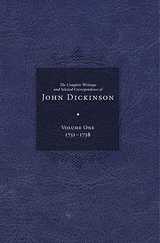 Complete Writings and Selected Correspondence of John Dickinson: Volume 1
Jane E. Calvert
University of Delaware Press, 2011 The Complete Writings and Selected Correspondence of John Dickinson, vol. 1 inaugurates a multivolume documentary edition that will, for the first time ever, provide the complete collection of everything Dickinson published on public affairs over the course of his life. The documents include essays, articles, broadsides, resolutions, petitions, declarations, constitutions, regulations, legislation, proclamations, songs and odes. Among them are many of the seminal state papers produced by the first national congresses and conventions. Also included are correspondences between Dickinson and some of the key figures of his era. This edition should raise Dickinson to his rightful place among America’s founding fathers, rivaled in reputation only by Benjamin Franklin before 1776. Dickinson was celebrated throughout the colonies, as well as in England and France, as the great American spokesman for liberty, and the documents in this edition evidence his tireless political work and unmatched corpus.
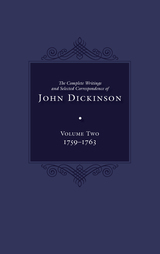 The Complete Writings and Selected Correspondence of John Dickinson: Volume 2
Jane E. Calvert
University of Delaware Press, 2021 John Dickinson’s entry into public life in Delaware and Pennsylvania is a highlight of the ninety-eight documents written over four years printed in Volume Two of The Complete Writings and Selected Correspondence of John Dickinson. The volume opens with Dickinson’s legal notes as he established himself as one of the most prominent and learned lawyers in colonial British North America. His cases dealt with, among other issues, interpretation of wills, disputes over land, sailors suing for wages, a fine on a Quaker who refused military service, and a notorious murder in a prominent Philadelphia family. It concludes with Dickinson offering thoughtful advice to a young man who was considering the arduous work in becoming a lawyer. “I think,” he wrote, “those must be infinitely the most happy, whose fatigues are softend by a conscious Benevolence of mind wishing & endeavouring to [pro]mote the Happiness of others as well as their own.”
Dickinson’s hard work on behalf of his clients brought him success in other areas of his public life. In October 1759, he was elected to his first public position as a representative for Kent County, Del., the following year he was elevated to the position of speaker, and in 1762, he became a representative for Philadelphia County, Pa. As a legislator in two colonies, learning his craft as a global war unfolded, he contributed to bills on military and defense, Indian relations, infrastructure improvements and city management, and served on various committees. The death of George II occasioned debates over laws and judges, in which Dickinson participated. This era concludes with Dickinson playing a central role in managing the unfolding Paxton Riots, in which frontiersmen massacred peaceful Indians and threatened the Quaker leadership of Pennsylvania.
In private, Dickinson lost the two most prominent male figures in his life in 1760, his father, Samuel, and soon thereafter, his mentor, colleague, and friend, John Moland. In honor of Moland, Dickinson published a poem and became a proxy head to Moland’s large family. Though his extant correspondence during this period is small, he exchanged letters with Mary Cadwalader Dickinson, Israel Pemberton, William Allason, George Read, Thomas McKean, and others. Perhaps most significant, he wrote a lengthy, unpublished essay on the flag-of-truce trade and also maintained commonplace books as he considered his place within the British Empire, opening up the next phase in Dickinson’s life as a leader of the resistance against Britain.
Published by the University of Delaware Press. Distributed worldwide by Rutgers University Press.
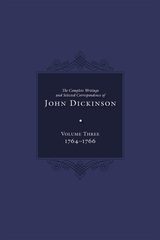 Complete Writings and Selected Correspondence of John Dickinson: Volume 3
Jane E. Calvert
University of Delaware Press, 2024 During the years 1764 through 1766, John Dickinson became a leading figure in the Pennsylvania Assembly and in the growing American resistance to unjust British taxation. The documents in this volume show that, in both roles, he sought to protect the fundamental rights of ordinary Americans. In the 1764 Assembly, after working to punish those responsible for the slaughter of peaceful Indians, Dickinson challenged Benjamin Franklin and Joseph Galloway in their plan to abolish Pennsylvania’s unique Quaker constitution that secured liberty of conscience and place the colony under the control of the Crown. Then, in 1765, he served as primary draftsman at the Stamp Act Congress in New York, producing the first official American documents of the Revolutionary Era. In his private capacity, Dickinson continued to write through 1765 and 1766, publishing, among other documents, the first practical advice to Americans on how to resist Great Britain. The present volume also contains draft legislation, fascinating case notes from his legal practice, and personal correspondence.
 Complete Writings and Selected Correspondence of John Dickinson: Volume 4, 1767-1769
John Dickinson
University of Delaware Press In 1767, John Dickinson began publishing his twelve Letters from a Farmer in Pennsylvania, which earned him international celebrity as the leader of the American resistance to Britain. They educated Americans about their rights and how to defend them without violence. Importantly, they also taught the colonists to unite and understand themselves first and foremost as Americans rather than as Britons. He followed with letters on religious liberty in the Episcopal controversy and America’s first patriotic song, the “Liberty Song.” This volume documents the overwhelming public response around the Atlantic World to his writings. It was largely positive, with readers paying tribute to him in numerous ways, beginning with the Massachusetts circular letter to the other colonies advocating a nonimportation agreement. Most of the negative responses came from Dickinson’s enemy from the 1764 royal government controversy in Pennsylvania, Joseph Galloway, who orchestrated a smear campaign against “the Farmer.” Dickinson’s legal notes from this period include several interesting cases, such as his defense of a mixed-race servant woman charged with infanticide. Although there is limited extant correspondence, it includes letters concerning his courtship of his future wife, Mary Norris.
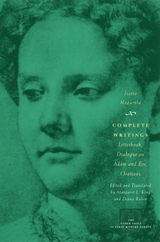 Complete Writings: Letterbook, Dialogue on Adam and Eve, Orations
Isotta Nogarola
University of Chicago Press, 2004 Renowned in her day for her scholarship and eloquence, Isotta Nogarola (1418-66) remained one of the most famous women of the Italian Renaissance for centuries after her death. And because she was one of the first women to carve out a place for herself in the male-dominated republic of letters, Nogarola served as a crucial role model for generations of aspiring female artists and writers.
This volume presents English translations of all of Nogarola's extant works and highlights just how daring and original her convictions were. In her letters and orations, Nogarola elegantly synthesized Greco-Roman thought with biblical teachings. And striding across the stage in public, she lectured the Veronese citizenry on everything from history and religion to politics and morality. But the most influential of Nogarola's works was a performance piece, Dialogue on Adam and Eve, in which she discussed the relative sinfulness of Adam and Eve—thereby opening up a centuries-long debate in Europe on gender and the nature of woman and establishing herself as an important figure in Western intellectual history. This book will be a must read for teachers and students of Women's Studies as well as of Renaissance literature and history.
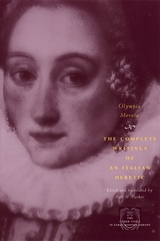 The Complete Writings of an Italian Heretic
Olympia Morata
University of Chicago Press, 2003 Winner of the 2004 Josephine Roberts Edition Prize from the Society for the Study of Early Modern Women.
A brilliant scholar and one of the finest writers of her day, Olympia Morata (1526-1555) was attacked by some as a "Calvinist Amazon" but praised by others as an inspiration to all learned women. This book publishes, for the first time, all her known writings—orations, dialogues, letters, and poems—in an accessible English translation.
Raised in the court of Ferrara in Italy, Morata was educated alongside the daughters of the nobility. As a youth she gave public lectures on Cicero, wrote commentaries on Homer, and composed poems, dialogues, and orations in both Latin and Greek. She also became a prominent Protestant evangelical, studying the Bible extensively and corresponding with many of the leading theologians of the Reformation. After fleeing to Germany in search of religious freedom, Morata tutored students in Greek and composed what many at the time felt were her finest works—a series of translations of the Psalms into Greek hexameters and sapphics.
Feminists and historians will welcome these collected writings from one of the most important female humanists of the sixteenth century.
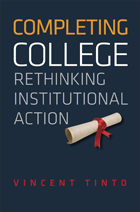 Completing College: Rethinking Institutional Action
Vincent Tinto
University of Chicago Press, 2012 Even as the number of students attending college has more than doubled in the past forty years, it is still the case that nearly half of all college students in the United States will not complete their degree within six years. It is clear that much remains to be done toward improving student success. For more than twenty years, Vincent Tinto’s pathbreaking book Leaving College has been recognized as the definitive resource on student retention in higher education. Now, with Completing College, Tinto offers administrators a coherent framework with which to develop and implement programs to promote completion.
Deftly distilling an enormous amount of research, Tinto identifies the essential conditions enabling students to succeed and continue on within institutions. Especially during the early years, he shows that students thrive in settings that pair high expectations for success with structured academic, social, and financial support, provide frequent feedback and assessments of their performance, and promote their active involvement with other students and faculty. And while these conditions may be worked on and met at different institutional levels, Tinto points to the classroom as the center of student education and life, and therefore the primary target for institutional action.
Improving retention rates continues to be among the most widely studied fields in higher education, and Completing College carefully synthesizes the latest research and, most importantly, translates it into practical steps that administrators can take to enhance student success.
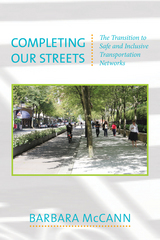 Completing Our Streets: The Transition to Safe and Inclusive Transportation Networks
Barbara McCann
Island Press, 2013 Across the country, communities are embracing a new and safer way to build streets for everyone—even as they struggle to change decades of rules, practice, and politics that prioritize cars. They have discovered that changing the design of a single street is not enough: they must upend the way transportation agencies operate. Completing Our Streets begins with the story of how the complete streets movement united bicycle riders, transportation practitioners and agencies, public health leaders, older Americans, and smart growth advocates to dramatically re-frame the discussion of transportation safety. Next, it explores why the transportation field has been so resistant to change—and how the movement has broken through to create a new multi-modal approach.
In Completing Our Streets, Barbara McCann, founder of the National Complete Streets Coalition, explains that the movement is not about street design. Instead, practitioners and activists have changed the way projects are built by focusing on three strategies: reframe the conversation; build a broad base of political support; and provide a clear path to a multi-modal process. McCann shares stories of practitioners in cities and towns from Charlotte, North Carolina to Colorado Springs, Colorado who have embraced these strategies to fundamentally change the way transportation projects are chosen, planned, and built.
The complete streets movement is based around a simple idea: streets should be safe for people of all ages and abilities, whether they are walking, driving, bicycling, or taking the bus. Completing Our Streets gives practitioners and activists the strategies, tools, and inspiration needed to translate this idea into real and lasting change in their communities.
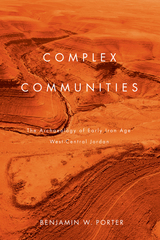 Complex Communities: The Archaeology of Early Iron Age West-Central Jordan
Benjamin W. Porter
University of Arizona Press, 2013 Complex Communities explores how sedentary settlements developed and flourished in the Middle East during the Early Iron Age nearly four thousand years ago. Using archaeological evidence, Benjamin Porter reconstructs how residents maintained their communities despite environmental uncertainties. Living in a semi-arid area in the present-day country of Jordan, villagers faced a harsh and unpredictable ecosystem. Communities fostered resilience by creating flexible production routines and leadership strategies. Settlements developed what archaeologists call “communal complexity,” a condition through which small-scale societies shift between egalitarian and hierarchical arrangements. Complex Communities provides detailed, scientifically grounded reconstructions of how this communal complexity functioned in the region.
These settlements emerged during a period of recovery following the political and economic collapse of Bronze Age Mediterranean societies. Scholars have characterized west-central Jordan’s political organization during this time as an incipient Moabite state. Complex Communities argues instead that the settlements were a collection of independent, self-organizing entities. Each community constructed substantial villages with fortifications, practiced both agriculture and pastoralism, and built and stocked storage facilities. From these efforts to produce and store resources, especially food, wealth was generated and wealthier households gained power over their neighbors. However, power was limited by the fact that residents could—and did—leave communities and establish new ones.
Complex Communities reveals that these settlements moved through adaptive cycles as they adjusted to a changing socionatural system. These sustainability-seeking communities have lessons to offer not only the archaeologists studying similar struggles in other locales, but also to contemporary communities facing negative climate change. Readers interested in resilience studies, Near Eastern archaeology, historical ecology, and the archaeology of communities will welcome this volume.
 Complex Deterrence: Strategy in the Global Age
Edited by T. V. Paul, Patrick M. Morgan, and James J. Wirtz
University of Chicago Press, 2009 As the costs of a preemptive foreign policy in Iraq have become clear, strategies such as containment and deterrence have been gaining currency among policy makers. This comprehensive book offers an agenda for the contemporary practice of deterrence—especially as it applies to nuclear weapons—in an increasingly heterogeneous global and political setting.
Moving beyond the precepts of traditional deterrence theory, this groundbreaking volume offers insights for the use of deterrence in the modern world, where policy makers may encounter irrational actors, failed states, religious zeal, ambiguous power relationships, and other situations where the traditional rules of statecraft do not apply. A distinguished group of contributors here examines issues such as deterrence among the Great Powers; the problems of regional and nonstate actors; and actors armed with chemical, biological, and nuclear weapons. Complex Deterrence will be a valuable resource for anyone facing the considerable challenge of fostering security and peace in the twenty-first century.
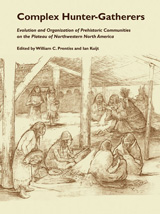 Complex Hunter Gatherers: Evolution Organization of Prehistoric Communities Plateau of Northwestern NA
William C Prentiss
University of Utah Press, 2004 The Plateau region of the Pacific Northwest witnessed the emergence, persistence, and decline of a diverse array of hunter-gatherer communities during the course of a past several thousand year period. Consequently, the region contains an archaeological record of groups who lived at times in permanent villages, employed complex resource procurement and processing strategies, participated in wide-ranging trade networks, and maintained social organizations featuring high degrees of social inequality. Complex Hunter-Gatherers presents a broad synthesis of the archaeology of the Plateau, inclusive of the Columbia and Fraser-Thompson drainages. The contributors seek to further our understanding of the nature of prehistoric social organization, subsistence practices, and lifeways of those living on the Plateau, and to expand upon this foundation to understand the evolution and organization of complex hunter-gatherers in general.
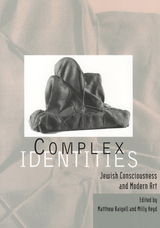 Complex Identities: Jewish Consciousness and Modern Art
Baigell, Matthew
Rutgers University Press, 2001 American and Israeli scholars examine how 19th and 20th century artists have responded to their jewishness through their art. Complex Identities is a joint effort by American and Israeli scholars who ask challenging questions about art as formed by society and ethnicity. Focusing on nineteenth– and twentieth–century European, American, and Israeli artists, the contributors delve into the many ways in which Jewish artists have responded to their Jewishness and to the societies in which they lived, and how these factors have influenced their art, their choice of subject matter, and presentation of their work. The contributions reflect a broad range of contemporary art criticism drawn from the history of art, culture, and literature. By analyzing how Jewish experiences have depicted and shaped art, the collection begins to answer how art, in its turn, depicts and shapes Jewish experience. An introduction by the volume editors unifies the essays and gives a historical overview.
Complex Predicates
Edited by Alex Alsina, Joan Bresnan, and Peter Sells
CSLI, 1996 Complex predicates can be defined as predicates which are composed of more than one grammatical element (either morphemes or words), each of which contributes a non-trivial part of the information of the complex predicate. The papers collected in this volume, which were presented at a workshop at Stanford in 1993, represent a variety of approaches to the question of the range and nature of complex predicates, and draw on data from a wide spectrum of languages. This collection develops a better understanding of the range of phenomena that a general theory of complex predicates would have to account for, and to see what kinds of linguistic ideas and methodologies would be necessary for such a task.
Complex Predicates and Information Spreading in LFG
Avery D. Andrews and Christopher D. Manning
CSLI, 1999 This book provides a simple but precise framework for describing complex predicates and related constructions, and applies it principally to the analysis of complex predicates in Romance, and certain serial verb constructions in Tariana and Miskitu. The authors argue for replacing the projection architecture of LFG with a notion of differential information spreading within a unified feature structure. Another important feature is the use of the conception of argument-structure in Chris Manning's Ergativity to facilitate the description of how complex predicates are assembled. In both of these aspects the result is a framework that preserves the descriptive parsimony of LFG while taking on key ideas from HPSG.
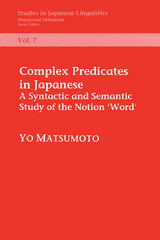 Complex Predicates in Japanese: A Syntactic and Semantic Study of the Notion 'Word'
Yo Matsumoto
CSLI, 1996 In this thoroughly revised version of 1992 Stanford dissertation, the author presents an extensive discussion of Japanese complex predicates. A broad range of constructions and predicates are discussed, which include predicative complement constructions, light verbs, causative predicates, desiderative predicates, syntactic and lexical compound verbs, and complex motion predicates. A number of new interesting facts are uncovered, and a detailed syntactic and semantic analyses are presented. On the basis of the analyses, the author argues that the notion 'word' must be relativized to at least three different senses: morphological, grammatical (functional), and semantic; and that this observation can be insightfully captured in the theory of Lexical-Functional Grammar. Previous proposals for each type of predicate that involve such mechanisms as argument transfer, incorporation, restructuring, etc. are thoroughly reviewed. Concrete proposals on the constraints on semantic wordhood are also made (an issue rarely discussed in the literature), drawing insights from cognitive linguistics.
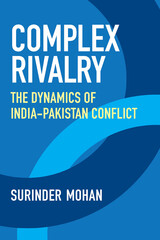 Complex Rivalry: The Dynamics of India-Pakistan Conflict
Surinder Mohan
University of Michigan Press, 2022 While a substantial body of research explains how the conflict between India and Pakistan originated and developed over time, a systematic and multivariate inquiry cutting across different IR paradigms to understand this rivalry is rare or limited. Surinder Mohan contributes to the understanding of India and Pakistan’s rivalry by presenting a new type of framework, also known as complex rivalry model. This comprehensive model, by not limiting its theoretical tool-kit to any single paradigm, is unique in its approach and better positioned to debate and answer baffling questions that the single-paradigm-based studies address rather inadequately and in isolation.
This book, through an examination of fifty-seven militarized disputes between 1947 and 2021, explains the life cycle of India-Pakistan rivalry in four phases: initiation; development; maintenance; and a possible transformation/termination. Mohan delineates five specific conditions that evolved the subcontinental conflict into a complex rivalry: first, its survival in spite of the Bangladesh War and the end of the Cold War; second, its linkage with other rivalries; third, the inclusion of nuclear factor; fourth, the dyadic stability in the militarized disputes and hostility level despite changes in the regime type; and fifth, the dyad’s involvement in a multilayered conflict pattern. To break this deadlock and mitigate their longstanding differences, Mohan proposes that India and Pakistan must reframe their national priorities and political goals so that the new situation or combinations of conditions would assist their peace strategists to downgrade the dyadic hostility and implement risky policies to make headway to a promising transformation.
 Complex Sleep
Tony Tost
University of Iowa Press, 2007 Complex Sleep, Tony Tost’s ambitious second book of poems, leaps upward with an astounding multiplicity of voices, utterances, and bursts. Each leap marks a sure and precise entry into a world of images, ideas, and sensations that is brand new—the true accomplishment of any poetic work. The octet of poems that compose Complex Sleep comprises a complex organism, audacious in scope, swiping at meaning via language as fragmented music. Tost takes on the problem of physical shape, reorchestrates phrases according to the alphabet, and writes himself into the hypnagogic state between waking and dreaming. Informed by their own procedural constraints, these poems invent forms that tap the unconscious poetic, the very complexity embodied in sleep. All the while, Tost reforms utterance beyond the mere epistemology of much contemporary poetry.
Devising an innovative formalism rather than concerning itself with discovering the what, Complex Sleep is about discovering how to say what needs to be said. Skip the opera, this book performs.
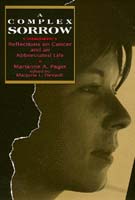 Complex Sorrow: Reflections on Cancer and an Abbreviated Life
Marianne Paget
Temple University Press, 1993 "The author's multiple voices--scholar, sociologist, victim--provide an academic, yet personal, professional, yet poignant, story....Readers face...the 'contradictory meanings' that an especially articulate woman brings to the final chapter of her life."
--Women and Health
In 1988, Marianne Paget published the Unity of Mistakes: A Phenomenological Interpretation of Medical Work (Temple) in which she argued that error is an intrinsic feature in medicine--an experimental and uncertain activity. Her subsequent research focused on medical negligence and on miscommunication and silence a as cause and product of error in medicine. While pursuing her research on negligence, she found out that she was an example of it. Chronic back pain that had been misdiagnosed as muscle spasms turned out to be a symptom of a rare and fatal cancer that claimed Paget's life in December 1989. This collection of her personal and professional writings on the phenomenon of error in medicine chronicles a young scholar's courageous struggle to make sense of a tragic coincidence.
Discovering that she was living the charges and painful topic that she had studied so deeply, Paget write poignantly and analytically until the last week of her life about this uncanny parallel. "It is very tricky to come to terms with the reality of death without becoming trapped in that reality," wrote "Tracy" Paget to her friends. In this book, she describes "the odd way my life began to mirror my work"; her search for "life rites" when face with tasks involving wills, last rites, and farewells; and her indomitable and forthright attempt to remain intensely alive in the face of death.
A Complex Sorrow, her final project, comprises essays, letters, and a journal recording her last year. Ever critical of the distanced and dispassionate stance taken in much social analysis, Paget had experimented with performance as a form for enlivening social science research. The script for her play, "The Work of Talk," about communication problems between a physician and his cancer patient, is also included. Her compelling life-text speaks to those living with illness and those who care for and about them, as the investigation and representation of lived experience.
Excerpt
Excerpt available at www.temple.edu/tempress
"Strangely, my knowledge of error has helped me deal with the errors in my care. Had I not known about the prevalence of error in medicine I would not have been able to process what has happened to me without bitterness. But I had thought these matters through already, and more than once. I now live out the complex sorrow I have before described."
--Marianne A. Paget
Reviews
"Paget's book is stunning. It's a tribute to the invulnerable human spirit. The woman burned like a flame; obviously she died well, because she lived well; she was loved because she was loving. The book is tremendously sad, but it isn't depressing; somehow, one is left with a sense of human possibility."
--Joan Cassell, author of Expected Miracles: Surgeons at Work
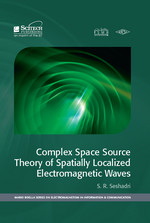 Complex Space Source Theory of Spatially Localized Electromagnetic Waves
S.R. Seshadri
The Institution of Engineering and Technology, 2014 This book begins with an essential background discussion of the many applications and drawbacks for paraxial beams, which is required in the treatment of the complex space theory of spatially localized electromagnetic waves. The author highlights that there is a need obtain exact full-wave solutions that reduce to the paraxial beams in the appropriate limit. Complex Space Source Theory of Spatially Localized Electromagnetic Waves treats the exact full-wave generalizations of all the basic types of paraxial beam solutions. These are developed by the use of Fourier and Bessel transform techniques and the complex space source theory of spatially localized electromagnetic waves is integrated as a branch of Fourier optics. Two major steps in the theory are described as: 1) the systematic derivation of the appropriate virtual source in the complex space that produces the required full wave from the paraxial beam solution and 2) the determination of the actual secondary source in the physical space that is equivalent to the virtual source in the complex space.
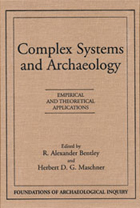 Complex Systems and Archaeology
Bentley, Alexander & Maschner, Herbert
University of Utah Press, 2003
Complexity science transects many fields ranging from physics to economics to biology. Its focus is the study of systems of interacting factors, which has lately been extended to include behavior in human societies. In prehistoric societies, whether these agents are defined at the scale of individuals, groups, households, or villages all agents are connected in such a way that change in the actions of one affects many others.
Complex Systems and Archaeology presents a useful introduction to complexity theory followed by a series of case studies in which human societies and environments are viewed as open systems into and out of which matter or energy can flow. Examples of such systems include the introduction of new crops, the creation of new artifacts, or the flux of products in a market.
This volume will have important implications for how archaeologists understand the dynamics of culture change and how they think about chronological stages, unique events, and the role of human agents.
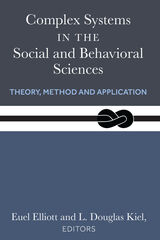 Complex Systems in the Social and Behavioral Sciences: Theory, Method and Application
Euel Elliott and L. Douglas Kiel, eds.
University of Michigan Press, 2021 Complexity Systems in the Social and Behavioral Sciences provides a sophisticated yet accessible account of complexity science or complex systems research. Phenomena in the behavioral, social, and hard sciences all exhibit certain important similarities consistent with complex systems. These include the concept of emergence, sensitivity to initial conditions, and interactions between agents in a system that yield unanticipated, nonlinear outcomes. The topics discussed range from the implications for artificial intelligence and computing to questions about how to model complex systems through agent-based modeling, to complex phenomena exhibited in international relations, and in organizational behavior. This volume will be an invaluable addition for both the general reader and the specialist, offering new insights into this fascinating area of research.
Complex Words, Causatives, Verbal Periphrases and the Gerund: Romance Languages versus Czech (A Parallel Corpus-Based Study)
Edited by Petr Cermák, Dana Kratochvílová, Olga Nadvornikova, and Pavel Štichauer
Karolinum Press, 2020 This book focuses on the typological differences among the four most widely spoken Romance languages--French, Italian, Portuguese, and Spanish--and Czech. Utilizing findings from the Czech National Corpus’ massive language database, the authors analyze a range of linguistic categories to discover the differences and similarities between Czech and the Romance languages. Due to the massive amount of data mined, as well as the high number of languages examined, this book presents general and individual typological features of the four Romance languages and Czech that often exceed what has previously been accepted in the field of comparative linguistics.
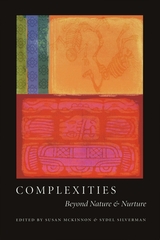 Complexities: Beyond Nature and Nurture
Edited by Susan McKinnon and Sydel Silverman
University of Chicago Press, 2005 Recent years have seen a growing impetus to explain social life almost exclusively in biological and mechanistic terms, and to dismiss cultural meaning and difference. Daily we read assertions that everything from disease to morality—not to mention the presumed characteristics of race, gender, and sexuality—can be explained by reference primarily to genetics and our evolutionary past.
Complexities mobilizes experts from several fields of anthropology—cultural , archaeological, linguistic, and biological—to offer a compelling challenge to the resurgence of reductive theories of human biological and social life. This book presents evidence to contest such theories and to provide a multifaceted account of the complexity and variability of the human condition. Charting a course that moves beyond any simple opposition between nature and nurture, Complexities argues that a nonreductive perspective has important implications for how we understand and develop human potential.
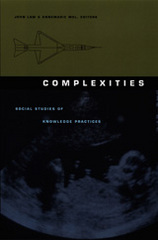 Complexities: Social Studies of Knowledge Practices
John Law and Annemarie Mol, eds.
Duke University Press, 2002 Although much recent social science and humanities work has been a revolt against simplification, this volume explores the contrast between simplicity and complexity to reveal that this dichotomy, itself, is too simplistic. John Law and Annemarie Mol have gathered a distinguished panel of contributors to offer—particularly within the field of science studies—approaches to a theory of complexity, and at the same time a theoretical introduction to the topic. Indeed, they examine not only ways of relating to complexity but complexity in practice.
Individual essays study complexity from a variety of perspectives, addressing market behavior, medical interventions, aeronautical design, the governing of supranational states, ecology, roadbuilding, meteorology, the science of complexity itself, and the psychology of childhood trauma. Other topics include complex wholes (holism) in the sciences, moral complexity in seemingly amoral endeavors, and issues relating to the protection of African elephants. With a focus on such concepts as multiplicity, partial connections, and ebbs and flows, the collection includes narratives from Kenya, Great Britain, Papua New Guinea, the Netherlands, France, and the meetings of the European Commission, written by anthropologists, economists, philosophers, psychologists, sociologists, and scholars of science, technology, and society.
Contributors. Andrew Barry, Steven D. Brown, Michel Callon, Chunglin Kwa, John Law, Nick Lee, Annemarie Mol, Marilyn Strathern, Laurent Thévenot, Charis Thompson
Complexity: Life at the Edge of Chaos
Roger Lewin
University of Chicago Press, 2000 "Put together one of the world's best science writers with one of the universe's most fascinating subjects and you are bound to produce a wonderful book. . . . The subject of complexity is vital and controversial. This book is important and beautifully done."—Stephen Jay Gould
"[Complexity] is that curious mix of complication and organization that we find throughout the natural and human worlds: the workings of a cell, the structure of the brain, the behavior of the stock market, the shifts of political power. . . . It is time science . . . thinks about meaning as well as counting information. . . . This is the core of the complexity manifesto. Read it, think about it . . . but don't ignore it."—Ian Stewart, Nature
This second edition has been brought up to date with an essay entitled "On the Edge in the Business World" and an interview with John Holland, author of Emergence: From Chaos to Order.
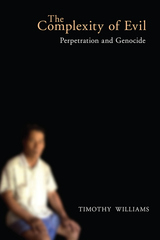 The Complexity of Evil: Perpetration and Genocide
Timothy Williams
Rutgers University Press, 2021 Why do people participate in genocide? The Complexity of Evil responds to this fundamental question by drawing on political science, sociology, criminology, anthropology, social psychology, and history to develop a model which can explain perpetration across various different cases. Focusing in particular on the Holocaust, the 1994 genocide against the Tutsi in Rwanda, and the Khmer Rouge genocide in Cambodia, The Complexity of Evil model draws on, systematically sorts, and causally orders a wealth of scholarly literature and supplements it with original field research data from interviews with former members of the Khmer Rouge. The model is systematic and abstract, as well as empirically grounded, providing a tool for understanding the micro-foundations of various cases of genocide. Ultimately this model highlights that the motivations for perpetrating genocide are both complex in their diversity and banal in their ordinariness and mundanity. Download the open access ebook here.
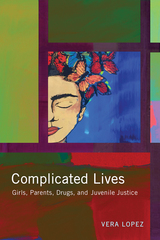 Complicated Lives: Girls, Parents, Drugs, and Juvenile Justice
Lopez, Vera
Rutgers University Press, 2017 Winner of the 2019 Intersectional Book Award from the American Society of Criminology's Division on Women & Crime
Complicated Lives focuses on the lives of sixty-five drug-using girls in the juvenile justice system (living in group homes, a residential treatment center, and a youth correctional facility) who grew up in families characterized by parental drug use, violence, and child maltreatment. Vera Lopez situates girls’ relationships with parents who fail to live up to idealized parenting norms and examines how these relationships change over time, and ultimately contribute to the girls’ future drug use and involvement in the justice system.
While Lopez’s subjects express concerns and doubt in their chances for success, Lopez provides an optimistic prescription for reform and improvement of the lives of these young women and presents a number of suggestions ranging from enhanced cultural competency training for all juvenile justice professionals to developing stronger collaborations between youth and adult serving systems and agencies.
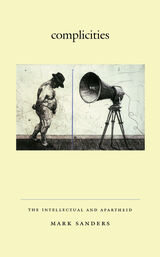 Complicities: The Intellectual and Apartheid
Mark Sanders
Duke University Press, 2002 Complicities explores the complicated—even contradictory—position of the intellectual who takes a stand against political policies and ideologies. Mark Sanders argues that intellectuals cannot avoid some degree of complicity in what they oppose and that responsibility can only be achieved with their acknowledgment of this complicity. He examines the role of South African intellectuals by looking at the work of a number of key figures—both supporters and opponents of apartheid. Sanders gives detailed analyses of widely divergent thinkers: Afrikaner nationalist poet N. P. van Wyk Louw, Drum writer Bloke Modisane, Xhosa novelist A. C. Jordan, Afrikaner dissident Breyten Breytenbach, and Black Consciousness leader Steve Biko. Drawing on theorists including Derrida, Sartre, and Fanon, and paying particular attention to the linguistic intricacy of the literary and political texts considered, Sanders shows how complicity emerges as a predicament for intellectuals across the ideological and social spectrum. Through discussions of the colonial intellectuals Olive Schreiner and Sol T. Plaatje and of post-apartheid feminist critiques of the Truth and Reconciliation Commission, Complicities reveals how sexual difference joins with race to further complicate issues of collusion. Complicities sheds new light on the history and literature of twentieth-century South Africa as it weighs into debates about the role of the intellectual in public life.
 Complicity and Moral Accountability
Gregory Mellema
University of Notre Dame Press, 2016 In Complicity and Moral Accountability, Gregory Mellema presents a philosophical approach to the moral issues involved in complicity. Starting with a taxonomy of Thomas Aquinas, according to whom there are nine ways for one to become complicit in the wrongdoing of another, Mellema analyzes each kind of complicity and examines the moral status of someone complicit in each of these ways. Mellema’s central argument is that one must perform a contributing action to qualify as an accomplice, and that it is always morally blameworthy to perform such an action. Additionally, he argues that an accomplice frequently bears moral responsibility for the outcome of the other’s wrongdoing, but he distinguishes this case from cases in which the accomplice is tainted by the wrongdoing of the principal actor. He further distinguishes between enabling, facilitating, and condoning harm, and introduces the concept of indirect complicity.
Mellema tackles issues that are clearly important to any case of collective and shared responsibility, yet rarely discussed in depth, always presenting his arguments clearly, concisely, and engagingly. His account of the nonmoral as well as moral qualities of complicity in wrongdoing—especially of the many and varied ways in which principles and accomplices can interact—is highly illuminating. Liberally sprinkled with helpful and nuanced examples, Complicity and Moral Accountability vividly illustrates the many ways in which one may be complicit in wrongdoing.
"In Complicity and Moral Accountability, Gregory Mellema has made an immensely important contribution to the discussion of group morality and collective responsibility both within and far beyond professional academic philosophy. His clearly written book will be essential reading." —Fergus Kerr, Honorary Fellow, University of Edinburgh
Composed Theatre: Aesthetics, Practices, Processes
Edited by Matthias Rebstock and David Roesner
Intellect Books, 2012 A unique contribution to an emerging field, Composed Theatre explores musical strategies of organization as viable alternative means of organizing theatrical work. In addition to insightful essays by a stellar group of international contributors, this volume also includes interviews with important practitioners, shedding light on historical and theoretical aspects of composed theatre.
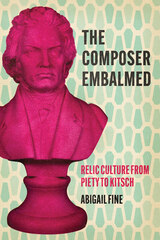 The Composer Embalmed: Relic Culture from Piety to Kitsch
Abigail Fine
University of Chicago Press, 2025 The first granular study of nineteenth-century composer devotion—a network of devotees who preserved tangible traces of composers through relics, rituals, pilgrimage, exhumation, and embalming.
During the nineteenth century, music institutions promoted artworks they deemed timeless and made composers into figureheads of a lasting Western canon. Alongside this institutional face of the canon was a more intimate impulse to preserve, touch, and embrace the residues of the dead. In Germany and Austria between 1870 and 1930, music lovers venerated the bodies, houses, and belongings of composers as relics, shrines, and talismans. In The Composer Embalmed, Abigail Fine documents the vernacular and eccentric ways that composers have been remembered.
Fine navigates a wealth of unknown archival material to recover the stories of devotees: from pilgrims who felt time stop in historic houses to music-loving doctors who made skulls into sacred specimens, dilettantes who displayed Beethoven’s mask as a relic of the “beautiful death,” and interwar critics of those dilettantes who disparaged piety as a false religion, a kitsch replica. In isolation, these practices may look like simple acts of affection. But in the aggregate, Fine asserts, acts of devotion constituted what we might broadly understand as relic culture—a culture that sought to possess the body of the departed genius, and that superimposed habits of anthropological collecting onto artifacts of Austro-German heritage. By excavating objects, ephemera, amateur lyric, visitors’ books, letters, and travelogues, The Composer Embalmed reveals the underbelly of the canon, where guilty pleasures blur the boundary between sanctity and desecration.
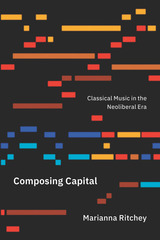 Composing Capital: Classical Music in the Neoliberal Era
Marianna Ritchey
University of Chicago Press, 2019 The familiar old world of classical music, with its wealthy donors and ornate concert halls, is changing. The patronage of a wealthy few is being replaced by that of corporations, leading to new unions of classical music and contemporary capitalism. In Composing Capital, Marianna Ritchey lays bare the appropriation of classical music by the current neoliberal regime, arguing that artists, critics, and institutions have aligned themselves—and, by extension, classical music itself—with free-market ideology. More specifically, she demonstrates how classical music has lent its cachet to marketing schemes, tech firm-sponsored performances, and global corporate partnerships. As Ritchey shows, the neoliberalization of classical music has put music at the service of contemporary capitalism, blurring the line between creativity and entrepreneurship, and challenging us to imagine how a noncommodified musical practice might be possible in today’s world.
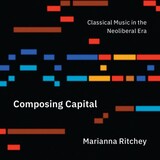 Composing Capital: Classical Music in the Neoliberal Era
Marianna Ritchey
University of Chicago Press, 2019 This is an auto-narrated audiobook edition of this book. The familiar old world of classical music, with its wealthy donors and ornate concert halls, is changing. The patronage of a wealthy few is being replaced by that of corporations, leading to new unions of classical music and contemporary capitalism. In Composing Capital, Marianna Ritchey lays bare the appropriation of classical music by the current neoliberal regime, arguing that artists, critics, and institutions have aligned themselves—and, by extension, classical music itself—with free-market ideology. More specifically, she demonstrates how classical music has lent its cachet to marketing schemes, tech firm-sponsored performances, and global corporate partnerships. As Ritchey shows, the neoliberalization of classical music has put music at the service of contemporary capitalism, blurring the line between creativity and entrepreneurship, and challenging us to imagine how a noncommodified musical practice might be possible in today’s world.
Composing Feminist Interventions: Activism, Engagement, Praxis
Kristine L. Blair
University Press of Colorado, 2018 This edited collection offers self-reflexive, critical accounts of how feminist writing studies scholars variously situated within rhetoric, composition, and literacy studies plan, implement, examine, and represent community-based inquiry and pedagogy. Readers will gain insight into the hows and whys involved with this important disciplinary work. Sharing a commitment to social change, the twenty-one chapter discussions and five course designs complicate and continue to evolve possibilities for how we conceptualize writing research and teaching as deeply collaborative, inclusive, and reciprocal practices.
Composing for the Jazz Orchestra
William Russo
University of Chicago Press, 1961 "Although it will be of primary interest to those who are engaged in composition themselves, [this] book is also recommended for readers who may wish to gain further insight into just what makes jazz composition so different from traditional approaches."—Malcolm Bessom, The Music Magazine
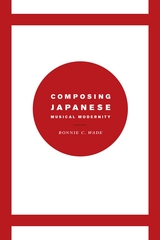 Composing Japanese Musical Modernity
Bonnie C. Wade
University of Chicago Press, 2013 When we think of composers, we usually envision an isolated artist separate from the orchestra—someone alone in a study, surround by staff paper—and in Europe and America this image generally has been accurate. For most of Japan’s musical history, however, no such role existed—composition and performance were deeply intertwined. Only when Japan began to embrace Western culture in the late nineteenth century did the role of the composer emerge. In Composing Japanese Musical Modernity, Bonnie Wade uses an investigation of this new musical role to offer new insights not just into Japanese music but Japanese modernity at large and global cosmopolitan culture.
Wade examines the short history of the composer in Japanese society, looking at the creative and economic opportunities that have sprung up around them—or that they forged—during Japan’s astonishingly fast modernization. She shows that modernist Japanese composers have not bought into the high modernist concept of the autonomous artist, instead remaining connected to the people. Articulating Japanese modernism in this way, Wade tells a larger story of international musical life, of the spaces in which tradition and modernity are able to meet and, ultimately, where modernity itself has been made.
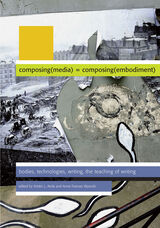 Composing Media Composing Embodiment
Kristin L. Arola and Anne Frances Wysocki
Utah State University Press, 2012 “What any body is—and is able to do—cannot be disentangled from the media we use to consume and produce texts.” ---from the Introduction. Kristin Arola and Anne Wysocki argue that composing in new media is composing the body—is embodiment. In Composing (Media) = Composing (Embodiment), they havebrought together a powerful set of essays that agree on the need for compositionists—and their students—to engage with a wide range of new media texts. These chapters explore how texts of all varieties mediate and thereby contribute to the human experiences of communication, of self, the body, and composing. Sample assignments and activities exemplify how this exploration might proceed in the writing classroom. Contributors here articulate ways to understand how writing enables the experience of our bodies as selves, and at the same time to see the work of (our) writing in mediating selves to make them accessible to institutional perceptions and constraints. These writers argue that what a body does, and can do, cannot be disentangled from the media we use, nor from the times and cultures and technologies with which we engage. To the discipline of composition, this is an important discussion because it clarifies the impact/s of literacy on citizens, freedoms, and societies. To the classroom, it is important because it helps compositionists to support their students as they enact, learn, and reflect upon their own embodied and embodying writing.
Composing Music: A New Approach
William Russo
University of Chicago Press, 1988 Aimed at those who have some knowledge of music but not formal training in composition, this concise introduction to composing starts right in with a brief composition exercise, then proceeds step by step through a series of increasingly complex and challenging problems, gradually expanding the student's musical grammar.
"This is a wonderful book for anyone who is developing improvising skills or who would like a fun way to explore music."—Jim Stockford, Co-Evolution Quarterly
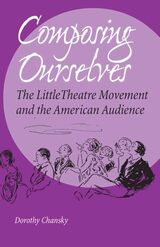 Composing Ourselves: The Little Theatre Movement and the American Audience
Dorothy Chansky
Southern Illinois University Press, 2005 When movies replaced theatre as popular entertainment in the years 1910–20, the world of live drama was wide open for reform. American advocates and practitioners founded theatres in a spirit of anticommercialism, seeking to develop an American audience for serious theatre, mounting plays in what would today be called “alternative spaces,” and uniting for the cause an eclectic group of professors, social workers, members of women’s clubs, bohemians, artists, students, and immigrants. This rebellion, called the Little Theatre Movement, also prompted and promoted the college theatre major, the inclusion of theatre pedagogy in K–12 education, prototypes for the nonprofit model, and the notion that theatre is a valuable form of self-expression. Composing Ourselves: The Little Theatre Movement and the American Audience argues that the movement was a national phenomenon, not just the result of aspirants copying the efforts of the much-storied Provincetown Players, Washington Square Players, Neighborhood Playhouse, and Chicago Little Theatre. Going beyond the familiar histories of the best-known groups, Dorothy Chansky traces the origins of both the ideas and the infrastructures for serious theatre that are ordinary parts of the American cultural landscape today; she also investigates the gender discrimination, racism, and class insensitivity that were embedded in reformers’ ideas of the “universal” and that still trouble the rhetoric of regional, educational, and community theatre. An important piece of revisionist history, Composing Ourselves shows how theatre reform, in keeping with other Progressive Era activism, took on corporate, conservative society, but did so in ways that were sometimes contradictory. For example, women constituted the majority of ticket buyers and the bulk of unsung labor, yet plays by women were considered inferior. Most reformers were comfortably middle class and sought change that would eliminate the anomie of modernity but not challenge their privileged positions. Chansky deliberates on antifeminist images of women theatergoers in literature and cartoons and considers the achievements and failures of the Drama League of America, a network of women’s clubs, following up with a case study of the playwright Alice Gerstenberg to point out that theatre history has not fully realized the role of women in the Little Theatre Movement. Even as women were earning the majority of degrees in newly minted theatre programs, their paths were barred to most professional work except teaching. Chansky also considers a blackface production of a play about rural African Americans, which was a step towards sympathetic portrayals of minority characters yet still a reinforcement of white upper- and middle-class perspectives.
 Composing Place: Digital Rhetorics for a Mobile World
Jacob Greene
Utah State University Press, 2022 Composing Place takes an innovative approach to engaging with the compositional affordances of mobile technologies. Mobile, wearable, and spatial computing technologies are more than the latest marketing gimmick from a perpetually proximate future; they are rather an emerging composing platform through which digital writers will increasingly create and distribute place-based multimodal texts. Jacob Greene utilizes and develops a rhetorical framework through which writers can leverage the affordances of these technologies by drawing on theoretical approaches within rhetorical studies, multimodal composition, and spatial theory, as well as emerging “maker” practices within digital humanities and critical media studies, to show how emerging mobile technologies are poised to transform theories, practices, and pedagogies of digital writing.
Greene identifies three emerging “modalities” through which mobile technologies are being used by digital writers. First, to counter dominant discourses in contested spaces; second, to historicize entrenched narratives in iconic spaces; and third, to amplify marginalized voices in mundane spaces. Through these modalities, Greene employs Indigenous philosophies and theories that upend the ways that the discipline has centered placed-based rhetorics, offering digital writers better strategies for using mobile media as a platform for civic deliberation, social advocacy, and political action.
Composing Place offers close analyses of mobile media experiences created by various artists and digital media practitioners, as well as detailed overviews of Greene’s own projects (also accessible through the companion website: www.composingplace.com). These projects include a digital “countertour” of SeaWorld that demonstrates the ways in which the attraction is driven by capitalism; an augmented reality tour of Detroit’s Woodward Avenue; and a mobile advocacy project in Jacksonville, Florida, that demonstrates the inequitable effects of car-centric public infrastructure. Ultimately, by engaging with these theoretical frameworks, rhetorical design principles, and pedagogical practices of mobile writing, readers can utilize the unique affordances of mobile media in various teaching and research contexts.
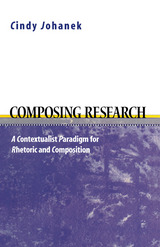 Composing Research: A Contextualist Paradigm for Rhetoric and Composition
Cindy Johanek
Utah State University Press, 2000 Cindy Johanek offers a new perspective on the ideological conflict between qualitative and quantitative research approaches, and the theories of knowledge that inform them. With a paradigm that is sensitive to the context of one's research questions, she argues, scholars can develop less dichotomous forms that invoke the strengths of both research traditions. Context-oriented approaches can lift the narrative from beneath the numbers in an experimental study, for example, or bring the useful clarity of numbers to an ethnographic study.
A pragmatic scholar, Johanek moves easily across the boundaries that divide the field, and argues for contextualist theory as a lens through which to view composition research. This approach brings with it a new focus, she writes. "This new focus will call us to attend to the contexts in which rhetorical issues and research issues converge, producing varied forms, many voices, and new knowledge, indeed reconstructing a discipline that will be simultaneously focused on its tasks, its knowledge-makers, and its students."
Composing Research is a work full of personal voice and professional commitment and will be a welcome addition to the research methods classroom and to the composition researcher's own bookshelf. 2000 Outstanding Scholarship Award from the International Writing Centers Association.
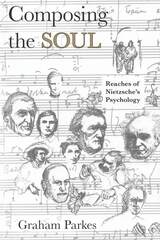 Composing the Soul: Reaches of Nietzsche's Psychology
Graham Parkes
University of Chicago Press, 1994 Nietzsche wrote in Ecce Homo (1888), "That a psychologist without equal speaks from my writings—this is perhaps the first insight gained by a good reader. . . . Who among the philosophers before me was in any way a psychologist? Before me there simply was no psychology."
Composing the Soul is the first study to pay sustained attention to this pronouncement and to examine the contours of Nietzsche's psychology in the context of his life and psychological makeup. Beginning with essays from Nietzsche's youth, Graham Parkes shows the influence of such figures as Goethe, Byron, and Emerson on Nietzsche's formidable and multiple talents. Parkes goes on to chart the development of Nietzsche's psychological ideas in terms of the imagery, drawn from the dialogues of Plato as well as from Nietzsche's own quasi-mystical experiences of nature, in which he spoke of the soul. Finally, Parkes analyzes Nietzsche's most revolutionary idea—that the soul is composed of multiple "drives," or "persons," within the psyche. The task for Nietzsche's psychology, then, was to identify and order these multiple persons within the individual—to compose the soul.
Featuring all new translations of quotations from Nietzsche's writings, Composing the Soul reveals the profundity of Nietzsche's lifelong personal and intellectual struggles to come to grips with the soul. Extremely well-written, this landmark work makes Nietzsche's life and ideas accessible to any reader interested in this much misunderstood thinker.
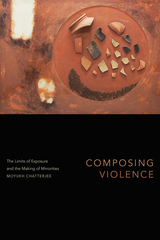 Composing Violence: The Limits of Exposure and the Making of Minorities
Moyukh Chatterjee
Duke University Press, 2023 In 2002, armed Hindu mobs attacked Muslims in broad daylight in the west Indian state of Gujarat. The pogrom, which was widely seen over television, left more than one thousand dead. In Composing Violence Moyukh Chatterjee examines how highly visible political violence against minorities acts as a catalyst for radical changes in law, public culture, and power. He shows that, far from being quashed through its exposure by activists, media, and politicians, state-sanctioned anti-Muslim violence set the stage for transforming India into a Hindu supremacist state. The state's and civil society’s responses to the violence, Chatterjee contends, reveal the constitutive features of modern democracy in which riots and pogroms are techniques to produce a form of society based on a killable minority and a triumphant majority. Focusing on courtroom procedures, police archives, legal activism, and mainstream media coverage, Chatterjee theorizes violence as a form of governance that creates minority populations. By tracing the composition of anti-Muslim violence and the legal structures that transform that violence into the making of minorities and majorities, Chatterjee demonstrates that violence is intrinsic to liberal democracy.
Composing while Dancing: An Improviser’s Companion
Melinda Buckwalter
University of Wisconsin Press, 2010 Composing while Dancing: An Improviser’s Companion examines the world of improvisational dance and the varied approaches to this art form. By introducing the improvisational strategies of twenty-six top contemporary artists of movement improvisation, Melinda Buckwalter offers a practical primer to the dance form. Each chapter focuses on an important aspect of improvisation including spatial relations, the eyes, and the dancing image. Included are sample practices from the artists profiled, exercises for further research, and a glossary of terms. Buckwalter gathers history, methods, interviews, and biographies in one book to showcase the many facets of improvisational dance and create an invaluable reference for dancers and dance educators.
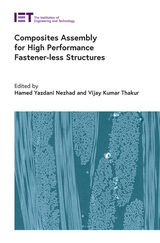 Composites Assembly for High Performance Fastener-less Structures
Hamed Yazdani Nezhad
The Institution of Engineering and Technology, 2022 Composites Assembly for High Performance Fastener-less Structures provides a broad and balanced span of information, covering both fundamentals and applications across academic and industrial state-of-the-art research and development on assembly, joining, inspection and repair of high-performance structures made from fibre-reinforced polymer composites and multifunctional nanocomposites. This knowledge is essential for the realisation of critical features in assembly and joining evolving procedures (across their design, development and performance analysis) in such multi-material systems, but also for the through-life maintenance of composite components used in a range of engineering applications such as those composite structures utilised for wind turbine blades, automotive parts, aircraft wings and fuselage. The book also addresses the non-destructive testing methods used to detect damage occurring in composite joints, which are essential to decide if the repair is needed.
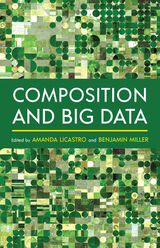 Composition and Big Data
Amanda Licastro, Benjamin M. Miller
University of Pittsburgh Press, 2021 In a data-driven world, anything can be data. As the techniques and scale of data analysis advance, the need for a response from rhetoric and composition grows ever more pronounced. It is increasingly possible to examine thousands of documents and peer-review comments, labor-hours, and citation networks in composition courses and beyond. Composition and Big Data brings together a range of scholars, teachers, and administrators already working with big-data methods and datasets to kickstart a collective reckoning with the role that algorithmic and computational approaches can, or should, play in research and teaching in the field. Their work takes place in various contexts, including programmatic assessment, first-year pedagogy, stylistics, and learning transfer across the curriculum. From ethical reflections to database design, from corpus linguistics to quantitative autoethnography, these chapters implement and interpret the drive toward data in diverse ways.
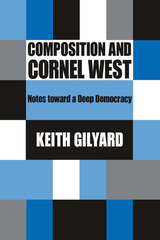 Composition and Cornel West: Notes toward a Deep Democracy
Keith Gilyard
Southern Illinois University Press, 2008 Composition and Cornel West: Notes toward a Deep Democracy identifies and explains key aspects of the work of Cornel West—the highly regarded scholar of religion, philosophy, and African American studies—as they relate to composition studies, focusing especially on three rhetorical strategies that West suggests we use in our questioning lives as scholars, teachers, students, and citizens. In this study, author Keith Gilyard examines the strategies of Socratic Commitment (a relentless examination of received wisdom), Prophetic Witness (an abiding concern with justice and the plight of the oppressed), and Tragicomic Hope (a keep-on-pushing sensibility reflective of the African American freedom struggle). Together, these rhetorical strategies comprise an updated form of cultural criticism that West calls prophetic pragmatism. This volume, which contains the only interview in which Cornel West directly addresses the field of composition,sketches the development of Cornel West’s theories of philosophy, political science, religion, and cultural studies and restates the link between Deweyan notions of critical intelligence and the notion of critical literacy developed by Ann Berthoff, Ira Shor, and Henry Giroux. Gilyard provides examples from the classroom to illustrate the possibilities of Socratic Commitment as part of composition pedagogy, shows the alignment of Prophetic Witness with traditional aims of critical composition, and in his chapter on Tragicomic Hope, addresses African American expressive culture with an emphasis on music and artists such as Curtis Mayfield, Marvin Gaye, Aretha Franklin, and Kanye West. The first book to comprehensively connect the ideas of one of America's premier scholars of religion, philosophy and African American studies with composition theory and pedagogy, Composition and Cornel West will be valuable to scholars, teachers, and students interested in race, class, critical literacy, and the teaching of writing.
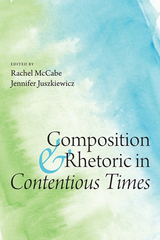 Composition and Rhetoric in Contentious Times
Rachel McCabe
Utah State University Press, 2023 Composition and Rhetoric in Contentious Times poses critical questions of representation, accessibility, social justice, affect, and labor to better understand the entwined future of composition and rhetoric. This collection of essays offers innovative approaches for socially attuned learning and best practices to support administrators and instructors. In doing so, these essays guide educators in empowering students to write effectively and prepare for their role as global citizens.
Editors Rachel McCabe and Jennifer Juszkiewicz consider how educators can respond to multiple current crises relating to composition and rhetoric with generosity and cautious optimism; in the process, they address the current concerns about the longevity of the humanities. By engaging with social constructivist, critical race, socioeconomic, and activist pedagogies, each chapter provides an answer to the question, How can our courses help students become stronger writers while contending with current social, environmental, and ethical questions posed by the world around them? The contributors consider this question from numerous perspectives, recognizing the important ways that power and privilege affect our varying means of addressing this question.
Relying on both theory and practice, Composition and Rhetoric in Contentious Times engages the future of composition and rhetoric as a discipline shaped by recent and current global events. This text appeals to early-career writing program administrators, writing center directors, and professional specialists, as well as Advanced Placement high school instructors, graduate students, and faculty teaching graduate-level pedagogy courses.
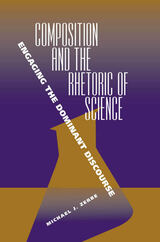 Composition and the Rhetoric of Science: Engaging the Dominant Discourse
Michael J. Zerbe
Southern Illinois University Press, 2007 Composition and the Rhetoric of Science: Engaging the Dominant Discourse calls for instructors of first-year writing courses to employ primary scientific discourse in their teaching and for rhetoricians of science to think about teaching scientific discourse as a literacy skill. Author Michael J. Zerbe argues that inclusion of scientific discourse is crucial because of this rhetoric’s status as the dominant discourse in western culture. The volume draws on Lyotard, Žižek, Foucault, and Althusser to argue that while important theorists such as these have recognized the dominance of scientific discourse, rhetoric and composition has not—to its detriment. The textillustrates that scientific discourse remains a miniscule part of the enterprise of rhetoric and composition and thus the field is not fulfilling its mission of providing students with the writing and reading skills they need to live and work in a science- and technology-dependent society.
Zerbe provides an analysis of science popularizations and demonstrates how these works can be used to contextualize primary scientific research. He also presents three pedagogical scenarios, each built around a carefully chosen, accessible example of scientific discourse, that demonstrate how articles from scientific journals can be used in writing courses.
Only by gaining a meaningful fluency in this discourse—one that is not offered by science textbooks—can a more sophisticated scientific literacy be assured. Composition and the Rhetoric of Science effectively explores the relatively limited amount of work done in rhetoric and composition on scientific discourse and questions this state of affairs. Zerbe presents for the first time cultural studies and science literacy as gateways for incorporating scientific discourse into first-year writing courses.
|
|
